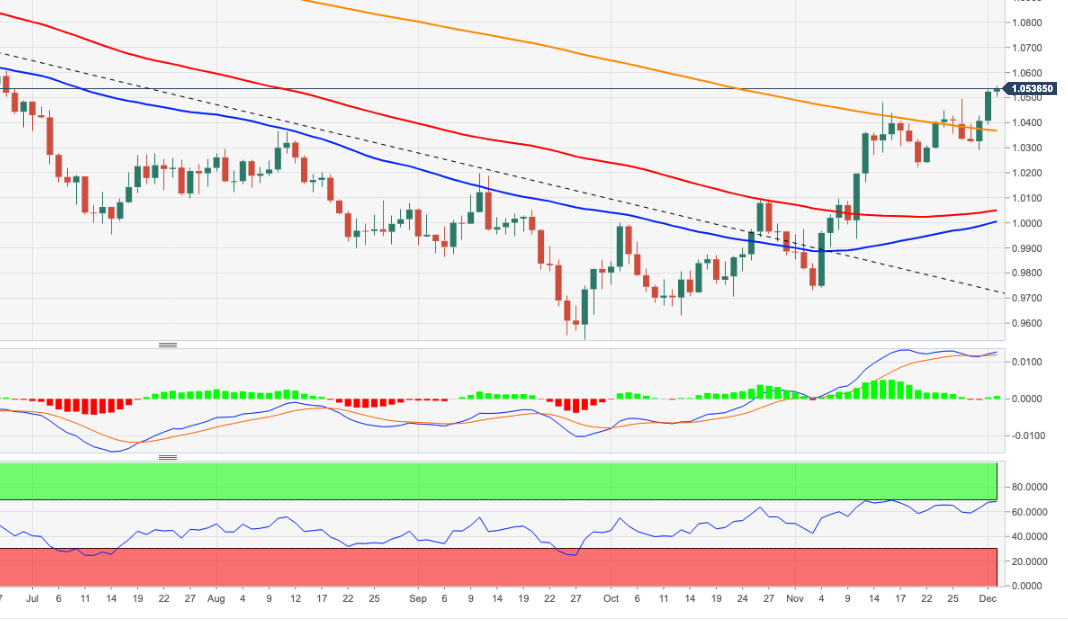- Analytics
- News and Tools
- Market News
CFD Markets News and Forecasts — 02-12-2022
- NZD/USD is set to finish the week with gains of 2.56%.
- The November US Nonfarm Payrolls suggested a tight labor market, so the Federal Reserve needs to keep hiking rates.
- NZD/USD Price Analysis: Daily close above 0.6400 exacerbates a rally towards 0.6570s.
The New Zealand Dollar (NZD) climbed against the US Dollar (USD) for the fourth consecutive day, spurred by a weaker USD. An upbeat employment report on the United States (US) suggested the Federal Reserve (Fed) might need to keep hiking rates to ease a contracted labor market, though it failed to underpin the US Dollar. Therefore, the NZD/USD is trading at 0.6404, above its opening price by 0.54%.
Wall Street finished the week lower. The US Department of Labor (DoL) revealed that November Nonfarm Payrolls rose 263K above estimates of 200K but trailed October’s data, revised up 284K, adding pressure on the Federal Reserve (Fed). Delving into the data, Average Hourly Earnings rose by 5.1% YoY, up from October’s 4.9%, adding to inflationary pressures, while the Unemployment Rate persisted around 3.7%.
Following the November employment report, the Federal Reserve would need to continue tightening borrowing costs, albeit on 50 bps sizes. In the last monetary policy press conference, Fed Chair Jerome Powell said that the pace of tightening it’s not as important as how high the Federal Funds rate (FFR) needs to be. Some Fed policymakers had forecasted the FFR to end at around 5% to 5.25%.
Federal Reserve’s decision to moderate hikes was justified by an Institute for Supply Management (ISM) Manufacturing PMI report for November. The index dropped to the contractionary territory at 49.0 but also portrayed conditions deteriorating. The data reignited recession fears as the US central bank continues to tighten policy. Indeed, the Federal Reserve is trying to slow the economy, accounting for below-trend growth, as the Fed Chair Powell had said.
Aside from this, an absent New Zealand (NZ) economic docket keeps NZD/USD traders adrift to US Dollar dynamics. It should be said that the Kiwi has rallied on broad US Dollar weakness. On the data front, the NZ Business Confidence report in November fell 14 points to -57.1 compared to October’s reading. Respondents foresee the economy deteriorating over the next year, while some respondents expect their business to shrink in the next 12 months.
NZD/USD Price Analysis: Technical outlook
From a technical perspective, the NZD/USD remains upward biased after surpassing the 200-day Exponential Moving Average (EMA) on Wednesday. Notably, during Friday’s session, the NZD/USD reached a daily low nearby the November 30 high of 0.6399 but bounced off and reclaimed the 0.6400 figure. After the major achieved a daily close above 0.6400, a test of the June 2022 high of 0.6576 is on the cards. The Relative Strength Index (RSI) in overbought territory suggests the NZD/USD might consolidate within the 0.6350-0.6400 range, while the Rate of Change (RoC) confirms that buyers remain in charge.
Therefore, the NZD/USD key resistance levels are the August 12 high of 0.6468, followed by the 0.6500 figure, and the June 2022 high of 0.6575.
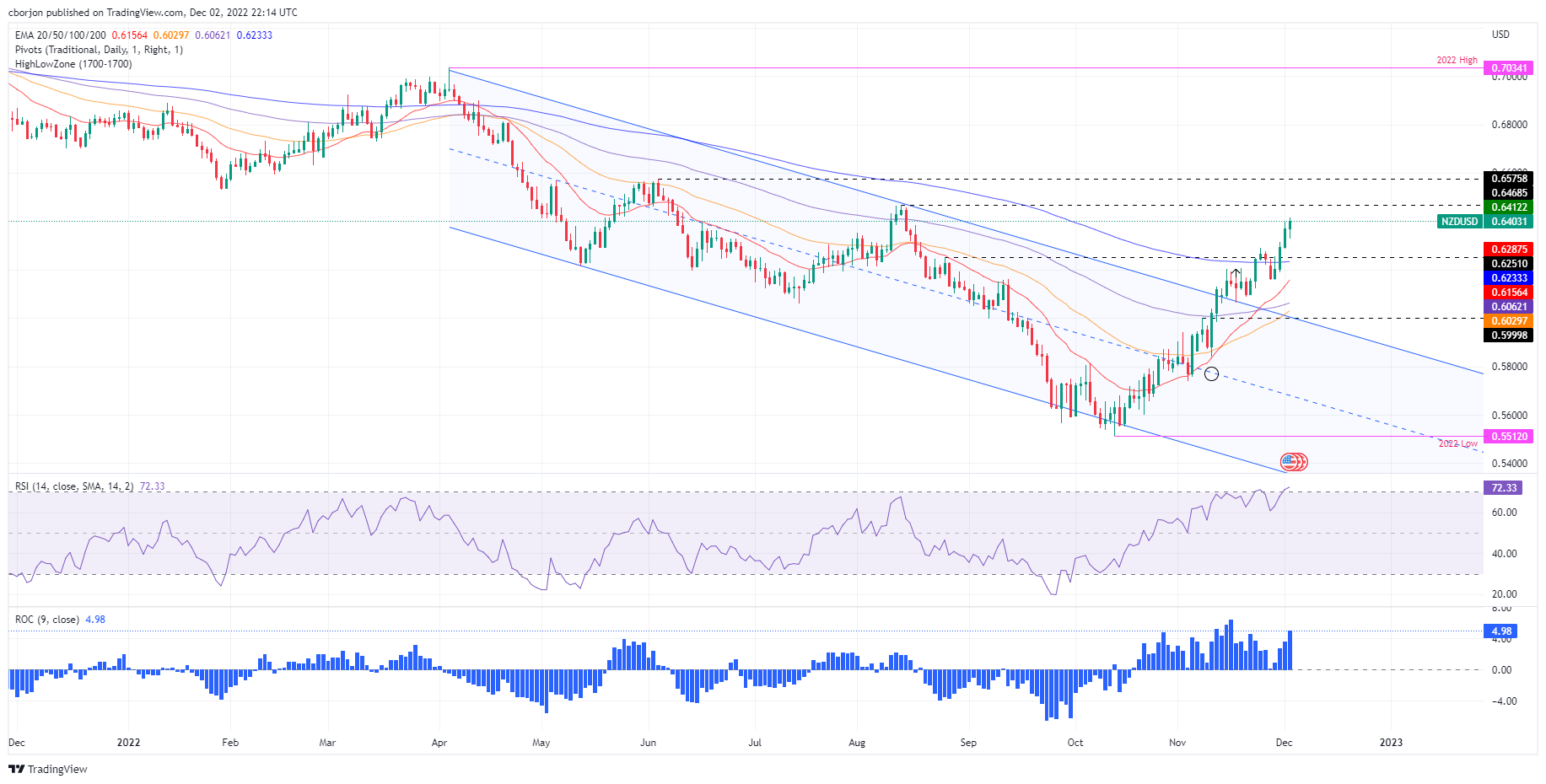
- The USD/JPY retraced from daily highs of 120 pips, as the USD is being offered.
- USD/JPY: Daily close below the 200-DMA opens the door for a drop to 131.70s.
The US Dollar (USD) gave away its earlier gains courtesy of upbeat economic data revealed in the United States (US) and dropped 0.52% against the Japanese Yen (JPY). At the time of writing, the USD/JPY is trading at 134.63, below the 200-day Exponential Moving Average (EMA), as the JPY gets ready to finish the week with gains of 3.26%.
USD/JPY Price Analysis: Technical outlook
The USD/JPY daily chart portrays the pair as downward biased after breaking the 200-day EMA and a five-month-old upslope support trendline. Nevertheless, upbeat US data exacerbated a rally toward Friday’s high of 135.98. However, the Relative Strength Index (RSI) at bearish territory and the Rate of Change (RoC) aiming lower showed that sellers were gathering momentum. Eventually, the USD/JPY erased those gains and some more.
If the USD/JPY achieves a daily close below the 200-day EMA at 134.99, it could pave the way for further downside action. The USD/JPY key support levels would be the psychological 134.00 figure. A breach of the latter could open the door for a 220 pip drop towards the August 11 low at 131.73, followed by August’s low at 130.39.

USD/JPY Key Technical Levels
- US Dollar remains weaker, despite upbeat US Nonfarm Payrolls report.
- The USD/CHF hit a daily high following the US NFP headline but plunged in the aftermath.
- USD/CHF: Break below 0.9370 to pave the way to the 0.9300 figure.
The USD/CHF trims some of its earlier losses/gains in a volatile trading session, spurred by a buoyant US Nonfarm Payrolls report for November, which increased the likelihood that the US Federal Reserve (Fed) will keep increasing borrowing costs. Nevertheless, manufacturing activity slowing reignited recession fears in the US economy. Therefore, the USD/CHF fluctuates around 0.9370s at the time of writing.
USD/CHF Price Analysis: Technical outlook
Friday’s session witnessed the USD/CHF rallying to its daily high of 0.9439 once the NFP headline crossed newswires. However, it was used by Swiss Franc (CHF) buyers to open fresh short positions on the USD/CHF, as shown by the major erasing its earlier gains, hoovering back below the psychological 0.9400.
Oscillators like the Relative Strength Index (RSI) at bearish territory is almost flat, suggesting consolidation ahead, while the 9-day Rate of Change (RoC) portrays sellers are in charge.
Therefore, the path of least resistance is downward biased. At the time of typing, the USD/CHF tests August 11 daily low of 0.9370, which, once cleared, could pave the way towards testing the fresh 7-month low of 0.9326, followed by the 0.9300 figure.

USD/CHF Key Technical Levels
- Silver price tumbled to its daily low but rallies to six-month highs at $23.22.
- US Nonfarm Payrolls report smashed estimates through an increase in wages to pressure the Federal Reserve.
- Silver Price Analysis: Upward biased, eyeing $24.00 and beyond.
Silver price rallied back above $23.00 after the release of an upbeat US jobs report bolstered the US Dollar (USD), while US Treasury bond yields advanced. Initially, the white metal trimmed some of its gains, traveling towards its daily low of $22.59, though as the USD weakens, it is rising again. At the time of writing, XAG/USD is trading at $23.13.
Federal Reserve pressured by an upbeat US employment report
Investors sentiment remains sour as US stocks trade with losses. The US Department of Labor (DoL) revealed that November Nonfarm Payrolls had risen 263K above estimates of 200K but trailed the previous month’s upward revised 284K, exerting pressure on the Federal Reserve (Fed). Delving into the data, the Unemployment Rate persisted around 3.7%, but wages increased. Average Hourly Earnings rose by 5.1% YoY, up from October’s 4.9%, adding to inflationary pressures.
Should be noted that the employment report would keep the Federal Reserve on the path to continue tightening monetary policy, even if it signifies to do it at smaller sizes, as the Federal Reserve Chair Jerome Powell stated on Wednesday.
The Federal Reserve’s decision to moderate hikes was further justified by a weaker Institute for Supply Management (ISM) Manufacturing PMI report for November. The index dropped to the contractionary territory at 49.0 but also portrayed conditions deteriorating. The data reignited recession fears as the US central bank continues to tighten policy. Indeed, the Federal Reserve is trying to slow the economy, accounting for below-trend growth, as the Fed Chair Powell had said.
In the meantime, after reclaiming 105.000, the US Dollar Index (DXY) drops 0.12%, down to 104.610, contrary to US Treasury yields. The US 10-year T-bond is yielding 3.559%, up five bps, bolstered by traders readjusting the peak for the Federal Funds rate (FFR) at 4.94%.
What to watch
Next week, the US economic docket will feature the ISM Non-Manufacturing PMI, Initial Jobless Claims, the Producer Price Index (PPI), and the University of Michigan (UoM) Preliminary release of the Consumer Sentiment.
Silver Price Forecast: XAG/USD Technical Outlook
The daily chart shows that the XAG/USD broke to fresh six-month highs during the London fix. Traders should note that the white metal plunged, but buyers stepped around the day’s lows and lifted XAG/USD toward $23.22. Oscillators led by the Relative Strength Index (RSI) flashes signals that Silver is overbought, though the 9-day Rate of Change (RoC) shows that buyers remain in charge. Therefore, the XAG/USD bias is upwards.
XAG/USD key resistance levels lie at $24.00, followed by the $25.00 figure, ahead of the February 2022 high of $25.61.
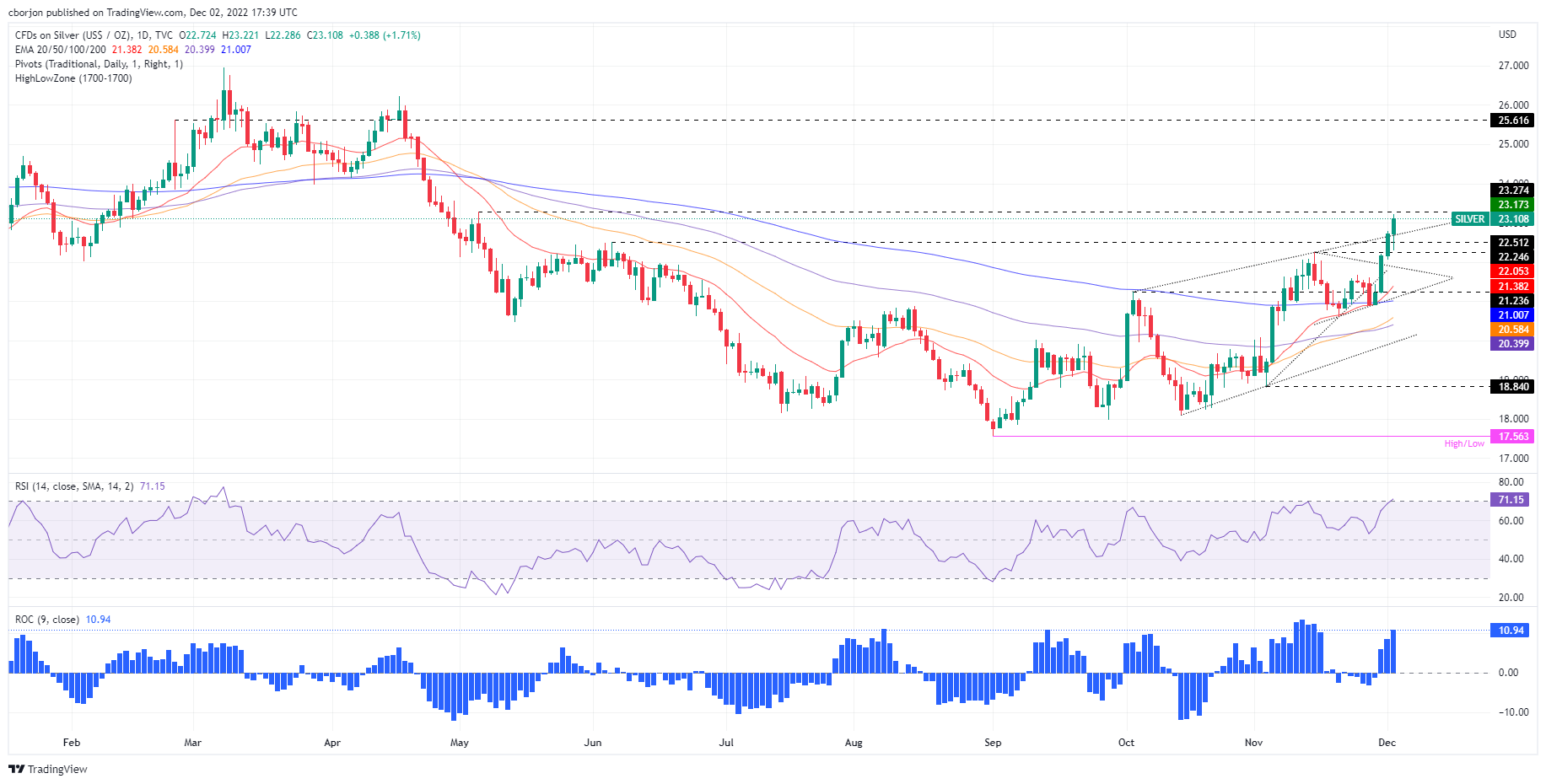
The Mexican Peso has been rising versus the US Dollar over the last weeks. Analysts at MUFG Bank, argue the resilience of the Mexican Peso might not last long amid domestic and external risks. Their forecast is for USD/MXN to reach 19.80 by the end of the first quarter 2023 and 20.00 by the third quarter.
Key Quotes:
“The Mexican peso continued its strengthening path in November helped by improving risk sentiment and a weaker US dollar supported by expectations for a slower pace of Fed hikes.”
“Further Fed hikes albeit slower along with the resilient core inflation in Mexico leads to the expectation of further interest rate hikes in Mexico. We expect a further 50bps hike in December meeting to 10.50%, followed by a final rate hike to 11.00% early next year. Although such scenario might be favourable for MXN appreciation, we see a set of risk factors that might revert the MXN appreciation observed in the latest months.”
“The scenario of some recession in the United States affects Mexican growth path.”
“We keep our bearish forecast profile for MXN due to building fears of a sharp global economic slowdown, and domestic risks coming from potential radical AMLO policies leading to some increased fiscal imbalances. Such risks are higher in a circumstance of weaker economic growth ahead that could impact Lopez Obrador’s popularity that is currently at quite high levels (61% approval rating).”
The Indian rupee is likely to depreciate moderately due to the potential strengthening of the US dollar in the near term, according to analysts at MUFG Bank. They forecast USD/INR at 82.300 by the end of the first quarter of next year and at 80.500 by the third quarter.
Key Quotes:
“Tracking gains in most emerging Asian peers, the INR advanced mildly last month along with a mild gain in India’s stock market, with the benchmark BSE Sensex up 3.2% to 62,858 as foreigners’ net purchased USD3.11 billion worth of Indian equities in November. Easing crude oil prices also offered some support to the currency.”
“The RBI is likely to hike the benchmark repo rate by 50bps at the upcoming meeting on 7th December to further contain inflationary pressures. As inflation moderates further and falls into the central bank’s target range, the RBI will likely keep rates stable for a while and shifts some focus to growth.”
“In the near term, we see that fundamental factors including Fed rate hikes, a stronger US dollar, trade deficits and India’s soaring fiscal deficits, are likely to weigh on the INR, and China factor could also bring volatility to USD/INR movements. The strengthening of INR likely happens when Fed pivots and US dollar begins to weaken in 2Q2023. We expect USD/INR to end this year at 82.000, and next year at 79.800.
"We are probably going to have a slightly higher peak to Fed policy rate even as we slow pace of rate hikes," Chicago Fed President Charles Evans said on Friday, as reported by Reuters.
"We're on a path to getting financial conditions appropriately restrictive to bring inflation down to 2%," Evans noted and added that they are well-positioned to be evaluating some very clear improvements on inflation.
Market reaction
The US Dollar Index clings to modest recovery gains following these remarks and was last seen rising 0.32% on the day at 105.05.
On Friday, the Canadian employment report showed better-than-expected numbers. The Loonie fell against the US Dollar but rose against its other rivals. Analysts at CIBC point out that the report supports their view that the Bank of Canada will increase rates by 50 bps next week, before pausing in 2023.
Key Quotes:
“After a roller coaster few months, the Canadian labour market moved sideways in November. The 10.1K job gain was in line with consensus expectations, as gains in full-time jobs were almost fully offset by losses in part-time employment. Looking through the volatility inherent to this series, the Canadian labour market has largely stood still over the past 6 months, with average gains of just over 4K a month.”
“There were no big surprises in this report. Therefore, and given the low unemployment rate, composition of employment changes and strong and stable wage growth, we continue to expect the Bank of Canada to deliver another 50 bps hike next week, before pausing in 2023. There's not a huge difference, however, between a one-off 50 basis point move and the most likely alternative, two 25 bps hikes in succession, in terms of what it would mean for the economy.”
The US Dollar trimmed weekly losses following the release of the US employment report that showed better-than-expected numbers. Analysts at Wells Fargo, point out that employment gains were fairly broad-based across industries, including in cyclically-sensitive sectors like construction and manufacturing. They argue the labor market remains far too hot for the Fed's liking, and it will take much slower growth in employment and wages to return inflation to the central bank's 2% target on a sustained basis.
Key Quotes:
“Nonfarm payrolls once again blew past expectations, increasing by 263K in November. Employment gains were fairly broad-based across industries, including in cyclically-sensitive sectors like construction and manufacturing. Average hourly earnings growth was much stronger than anticipated, and new labor supply that might help put water on the fire was once again not forthcoming: the labor force participation rate fell by a tenth and is now below where it was in January.”
“Payroll growth of 263K is still too fast at this stage of the business cycle, and wage growth of ~5% is 1-1/2 percentage points above what would be consistent with the Fed's inflation target. A downshift to a 50 bps rate hike in December seems likely, but the Fed still has a ways to go in its tightening cycle.”
Analysts at MUFG Bank, point out that the stress on the Korean Won is unlikely to fade in a near term horizon. They forecast USD/KRW at 1330.0 by the end of the first quarter of next year and at 1270.0 in twelve months.
Key Quotes:
“The won appreciated last month on improving risk-on sentiment spurred by the prospect of a slower pace of Fed rate hikes. The performance of KRW was consistent with benchmark KOSPI Index rising more than 7% and foreign investors’ net buying of USD2 billion worth in Korean equities in the month.”
“Data-wise, South Korea’s current account balance flipped to a surplus of USD1.61 bn in September after a deficit of USD3.05 bn in August; the country’s lower-than-expected unempolyment rate (2.8% in November vs Bloomberg consenus’s 2.9%); and continuous efforts to stabilize its credit market, these helped boost sentiment. Having said that, its latest economic indictors still pointed to the weakness ahead. South Korea’s early exports (first 20 days) contracted for the third straight month in November, indicating the risk to a trade-reliant part of the economy amid softening external demand.”
“The growth deceleration, and the potential strengthening of the dollar in upcoming quarter implies a slightly weaker KRW. We expect USD/KRW to end this year at 1,320.0.”
Gold Price is set to close the week in positive territory despite Friday's pullback. XAU/USD eyes a break above $1,800 as preserves its bullish bias, FXStreet’s Eren Sengezer reports.
XAU/USD to attract additional buyers above $1,800
“On the upside, $1,800 (psychological level, 200-day Simple Moving Average (SMA) aligns as a key pivot level. Once XAU/USD stabilizes above that level by using it as support, it could target $1,830 (Fibonacci 50% retracement of the long-term downtrend) and $1,860 (static level) next.”
“If Gold price falls below $1,780 (Fibonacci 38.2% retracement) and fails to reclaim that level, sellers could show interest and drag XAU/USD lower toward $1,740 (static level) and $1,720 (Fibonacci 23.6% retracement, 50-day SMA).”
- US November’s Nonfarm Payrolls crushed estimates, and wages rose.
- The US Dollar reclaimed the 105.000 mark, underpinned by high US bond yields.
- RBA’s Lowe: “Australia’s inflation expectations well anchored.”
The Australian Dollar (AUD) dropped against the US Dollar (USD) following the release of a positive employment report in the United States (US) which showed an increase in wages, pressuring the Federal Reserve (Fed) to take action. At the time of writing, the AUD/USD is trading at 0.6771 after hitting a daily high of 0.6832.
Positive US jobs data bolstered the US Dollar
US stocks are trading with losses after November’s US Nonfarm Payrolls (NFP) report. Data showed that the economy added 263,000 new jobs, and October’s was upward revised 284,000 jobs, the Department of Labor (DoL) report showed. In the same statement, the Unemployment Rate was unchanged at 2.7%, while Average Hourly Earnings rose by 5.1% YoY, vs. 4.6% consensus, reigniting wage inflation spirals, adding further pressure on the Fed.
The US Dollar Index (DXY), which tracks the greenback’s performance against six currencies, stages a recovery, gaining 0.49%, up at 105.234, underpinned by US Treasury yields. The US 10-year Treasury bond yield rises nine bps, at 3.599%.
Thursday, the Institute for Supply Management (ISM) revealed that November’s manufacturing activity in the US shrank to 49.0 from 50.2 in the previous month. The figures reignited recession fears, as the report showed new orders are falling, demand eased, and the employment index contracted. Therefore, investors’ mood dwindled, as demonstrated by US equities finishing the session with losses.
Meanwhile, Federal Reserve Chairman Jerome Powell opened the door for lower-sized rate hikes, reinforcing the latest meeting minutes sentence that “a substantial majority of participants judged that a slowing in the pace of increase would likely soon be appropriate.” On those remarks, the AUD/USD hit a fresh three-month high, though the rally stalled, on the US ISM report.
Earlier, during the Asian session, the Australian economic docket featured the release of Retail Sales for October, which shrank 0.2% MoM, vs. 0.6% expansion, while housing data remained in negative territory but was better-than-expected. Also, the Reserve Bank of Australia (RBA) Governor Philippe Lowe said that inflation expectations in Australia are “well anchored.” He added that domestic spending remains resilient amidst higher interest rates, and the RBA’s decision to moderate rate hikes reflects monetary policy lags.
AUD/USD Key Technical Levels
The Canadian Dollar is the third-best performing G10 currency year-to-date behind the safe havens Swiss Franc and US Dollar. Economists at Rabobank expect the USD/CAD pair to surge higher toward 1.38 by the end of the year.
CAD to outperform on the crosses in the coming months
“We still expect CAD to outperform on the crosses in the coming months despite seeing upside for USD/CAD.”
“USD/CAD has been volatile and will likely continue trading in wide ranges.”Our base case is for “USD/CAD to trade back to 1.38 by year-end.”
- US economy creates 263K jobs in November against 200K of market consensus.
- Canadian job markets adds 50.7K full time jobs in November.
- Loonie falls versus US dollar but strengthens against other rivals.
The USD/CAD jumped after the release of the employment reports from Canada and the US and peaked at 1.3520, the highest level in two days. It then pulled back to the 1.3450 area. It is still positive for the day but off highs.
Loonie gains on data…
Despite the spike in USD/CAD, the Canadian Dollar rose versus most of its rivals boosted by job market figures. The net change in employment in Canada in November was positive by 10.1K, against expectations of 5K. Full-time jobs increased by more than 50K. Wages rose 5.6% y/y.
“Some early signs that broader inflation pressures have started to ease, and indications that domestic demand is softening, mean the BoC could be close to the end of the current interest rate hiking cycle. But we expect another 25 basis point hike to the overnight rate at next week's central bank policy decision”, explained analysts at RBC Capital Markets.
But Dollar gains more on data
In November, the US economy added 263K jobs above the 200K of markets consensus. The Department of Labor announced the unemployment rate stood at 3.7%. Average Hourly Earnings put upward pressure on inflation, by rising 5.1% y/y.
The US Dollar jumped across the board as equity prices slide and US Treasury yields rose. The numbers keep the door open to more interest rate hikes. “The labor market remains far too hot for the Fed's liking, and it will take much slower growth in employment and wages to return inflation to the central bank's 2% target on a sustained basis”, mentioned analysts at Wells Fargo.
USD/CAD up but off highs
The pair is hovering around 1.3470, up for the day but far from the daily high. The same situation applies to the daily chart. On Tuesday, the pair peaked at 1.3646 but then pulled back 250 pips, finding support around the 1.3400 zone.
The 4-hour chart still shows a bullish bias supported by the 1.3400 area, a horizontal level and also where an uptrend line stands. A break lower should strengthen the Loonie.
Gold rose above $1,800 for the first time in four months. However, economists at TD Securities expect the buying appetite for the yellow metal to fade.
Positioning risks are no longer tilted to the upside
“After yesterday's sharp rally sent Gold prices above several key triggers catalyzing trend follower short covering, CTA trend followers are set to start adding shorts again this session.”
“At this juncture, positioning risks are no longer tilted to the upside in gold, and we see the first signs of buying exhaustion in gold as a rally north of $1,830 only points to marginal CTA buying from current positioning levels.”
In the last month, we have had a sharp sell-off in the US Dollar. Economists at Nordea expect the greenback to remain supported in the near-term, however, EUR/USD is set to edge higher next year.
Dollar’s rise on increasing recession risks to be brief
“In the short-term, we believe EUR/USD is bound for a slight pullback, rather than a quick trend reversal for a higher EUR/USD. Key to our thinking is that downside risks prevail in financial markets, which will benefit the safe haven USD.”
“Looking ahead, the USD is likely to rise initially in response to rising recession risks in the US and Europe, but not substantially unless we end up in a severe recession, which we do not expect.”
“We expect the USD to keep its shine in the short-term, but once investors focus on weakening growth and its impact on inflation, we expect EUR/USD to rise from historical low levels this year.”
- The Pound Sterling nosedived to 1.2133 once the headline crossed newswires.
- US November’s Nonfarm Payrolls crushed estimates, and wages rose.
- Traders focus on Chicago Fed Charles Evans’s speech around 15:00 GMT.
The GBP/USD dived from around 1.2290s close to 100 pips following a better-than-foreseen labor market report in the United States (US), suggesting that further central bank tightening is needed. However, in the aftermath of the US employment report, the GBP/USD is trading around 1.2210s, after traveling towards its daily low of 1.2133, on the market’s reaction to US headline data.
US equity futures remain downbeat after the November US Nonfarm Payrolls rose by 263,000 following an upward revision of 284,000 jobs added in October, the Department of Labor (DoL) report showed. Delving into the information, the Unemployment Rate stood at 3.7%, while Average Hourly Earnings put upward pressure on inflation, jumping 5.1% YoY, vs. 4.6%, consensus. Given that Federal Reserve (Fed) policymakers agreed that moderating the pace of rate hikes is appropriate, it would be interesting to see Fed officials’ postures, led by the Chicago Fed President Charles Evans, crossing newswires around 15:00 GMT.
The US Dollar Index (DXY), a gauge of the buck’s value against a basket of six currencies, after hitting six-month lows around 104.377, stages a mild recovery, reclaimed the 105.000 figure up 0.32%.
Aside from this, a weaker Institute for Supply Management (ISM) Manufacturing PMI report for November on Thursday flashed signs of activity contraction, shifted sentiment sour, spurring flows towards safety, except for the US Dollar (USD). On the inflation side, the Fed’s preferred gauge for inflation, the core Personal Consumption Expenditure (PCE) for October, rose by 5% YoY, below the previous month’s 5.2%, aligned with estimates.
An absent UK economic calendar leaves the GBP/USD pair adrift to the US Dollar dynamics. Given that the GBP/USD reached a fresh 5-month high at 1.2311, it was achieved on a soft USD after the Federal Reserve Chair Jerome Powell said that moderation on the speed of rate increases was “appropriate” Wednesday.
Ahead in the calendar, the US economic docket will feature the Chicago Fed President Charles Evans, ahead of the Fed’s blackout period, at the upcoming December monetary policy meeting.
GBP/USD Key Technical Levels
The Canadian labour market added another 10K jobs in November to match the market consensus. Economists at TD Securities think there is scope for CAD underperformance to come to an end, at least tactically.
A bang-on consensus expectations result does little for the CAD
“The November employment report showed job growth slowing to 10.1K, matching the market consensus, as weaker labour force participation helped pull the unemployment rate to 5.1%.”
“Today's report fits with our call for the Bank of Canada to hike by 25 bps next week, as there was little in the report to support a more aggressive move.”
“This number does little to impact the CAD. That said, we think there is scope for CAD underperformance to come to a tactical end on the crosses following much stronger US Nonfarm Payrolls and wage data.”
- US Dollar soars across the board after NFP.
- Better-than-expected numbers trigger a decline in US Treasuries.
- USD/JPY rises by almost 200 pips, finds resistance below 136.00.
The USD/JPY jumped from 134.10 to 135.95, after the release of the US official employment report that showed better-than-expected numbers. The pair then pulled back toward 135.00 after the initial reaction.
Jobs market still healthy, so is the Dollar?
Nonfarm Payrolls rose by 263K in November, the smallest since April 2021 but the number surpassed expectations and showed positive signs about the health of the labor market.
The US Dollar jumped after the report, while equity prices tumbles and US Treasury yields soared. The economic figures mean a go-ahead for the Federal Reserve to keep raising rates in order to control inflation. “This means that the labor market is hardly cooling off and remains stronger than the Fed would like”, said analysts at Commerzbank.
The combination of a stronger US Dollar and higher US yields sent the Japanese Yen to the downside across the board. It is still among the top performers of the day, but off highs.
The USD/JPY peaked at 135.95 and then pulled back. After the opening bell at Wall Street the pair is hovering at 135.10/30, as volatility remains elevated with market participants still digesting the NFP and its impact.
On a weekly basis, USD/JPY is headed toward the lowest close since mid-August, about to post the sixth weekly decline out of the last seven weeks.
Technical levels
Gold price surged by more than 8% in November. But the current rally on the Gold market could run out of steam ahead of the central bank meetings scheduled to take place the following week, according to strategists at Commerzbank.
Prospect of slower US rate hikes lends buoyancy to precious metals
“Precious metals have profited recently – partly thanks to the weaker US Dollar – from the prospect of more moderate rate hikes by the Fed. It is questionable whether the buoyancy will last until the end of the year, however.”
“Gold could shed some of its gains again in the run-up to the central bank meetings that are to take place the week after next.”
“It is above all long-term-oriented financial investors who still appear hesitant, though at least no further selling from the ETFs tracked by Bloomberg has been reported since mid-November.”
- The index bounces off multi-month lows post-NFP.
- The US economy added more jobs than expected in November.
- A 50 bps rate hike remains favoured despite robust Payrolls.
The Greenback, in terms of the USD Index (DXY), quickly reclaimed the area above the 105.00 mark following another strong result for US Nonfarm Payrolls on Friday.
USD Index appears supported near 104.40
The index manages to regain strong upside traction following solid prints from November’s Payrolls, which showed both the job creation and wage growth remained far from mitigated.
Indeed, the US economy added 263K jobs during last month (vs. 200K expected) and the Unemployment Rate remained at 3.7%, while Average Hourly Earnings rose more than expected 0.6% MoM and 5.1% from a year earlier. The Participation Rate, however, deflated marginally to 62.1% (from 62.2%).
Following the release of the jobs report, the probability of a 75 bps rate hike at the next Fed’s gathering (December 14) improved to nearly 30%, according to CME Group's FedWatch Tool.

Next on tap in the US docket comes the speech by Chicago Federal Reserve President Charles Evans (2023 voter, centrist).
What to look for around USD
The US Dollar seems to have met some decent contention around 104.30 for the time being.
While hawkish Fedspeak maintains the Fed’s pivot narrative in the freezer, upcoming results in US fundamentals would likely play a key role in determining the chances of a slower pace of the Fed’s normalization process in the short term.
Key events in the US this week: Nonfarm Payrolls, Unemployment Rate (Friday).
Eminent issues on the back boiler: Hard/soft/softish? landing of the US economy. Prospects for further rate hikes by the Federal Reserve vs. speculation of a recession in the next months. Fed’s pivot. Geopolitical effervescence vs. Russia and China. US-China persistent trade conflict.
USD Index relevant levels
Now, the index is gaining 0.58% at 105.33 and faces the next up barrier at 105.55 (200-day SMA) followed by 107.19 (weekly high November 30) and then 107.99 (weekly high November 21). On the other hand, the breakdown of 104.37 (weekly low December 2) would open the door to 103.41 (weekly low June 16) and finally 101.29 (monthly low May 30).
- Gold price retreats sharply from a multi-month top in reaction to upbeat US jobs data.
- Rising US Treasury bond yields prompt aggressive US Dollar short-covering and weigh.
- The risk-off impulse fails to impress bulls or lend support to the safe-haven XAU/USD.
Gold price struggles to find acceptance above a technically significant 200-day Simple Moving Average (SMA) and retreats from a nearly four-month high touched earlier this Friday. The intraday downtick picks up pace in reaction to the upbeat US jobs report and drags the XAU/USD to sub-$1,780 levels during the early North American session.
US employment details beat market expectations
The closely-watched Nonfarm Payrolls (NFP) from the United States showed that the economy added 263K new jobs in November, beating consensus estimates pointing to a reading of 200K. Adding to this, the previous month's print was also revised higher to show an addition of 284K vacancies as compared to the 261K reported originally. Meanwhile, the unemployment rate held steady at 3.7% during the reported month, as was anticipated.
Aggressive US Dollar short-covering weighs on Gold price
Additional details of the report showed that Average Hourly Earnings grew 0.6% in November and 5.1% YoY rate, suggesting a further rise in inflationary pressures. The data validates Federal Reserve Chair Jerome Powell's forecast that the peak rate will be higher than expected, which triggers a sharp rise in the US Treasury bond yields. This, in turn, prompts an aggressive US Dollar short-covering move and weighs heavily on the Dollar-denominated Gold price.
Risk-off impulse fails to lend support to safe-haven XAU/USD
Traders, meanwhile, seem rather unaffected by a sell-off in the equity markets, which tends to drive flows towards the safe-haven precious metal. Nevertheless, Gold price, for now, seems to have snapped four days of the winning streak, though remains on track to post strong weekly gains. Hence, it will be prudent to wait for strong follow-through selling before confirming that the XAU/USD has topped out and positioning for a deeper corrective pullback.
Gold price technical outlook
From a technical perspective, failure to find acceptance above the very important 200-day SMA and the subsequent downfall could be seen as the first sign of bullish exhaustion. That said, any further decline is likely to find some support near the $1,770 horizontal zone. A convincing break below should pave the way for a fall towards the next relevant support near the $1,755-$1,753 region.
On the flip side, the $1,800 round-figure mark now seems to act as an immediate hurdle ahead of the multi-month top, around the $1,804-$1,805 region. This is closely followed by the August 2022 swing high, around the $1,808 area, above which Gold price could climb to the $1,820 resistance zone.
Key levels to watch
- Unemployment Rate in Canada declined modestly in November.
- USD/CAD trades in positive territory at around 1.3500.
The data published by Statistics Canada revealed on Friday that the Unemployment Rate declined to 5.1% in November from 5.2% in October. This reading came in better than the market expectation of 5.3%.
Further details of the publication showed that the Net Change in Employment was +10.1K, slightly higher than analysts' estimate of +5K.
"The number of people employed on a full-time basis increased by 51,000 (+0.3%) in November," Statistics Canada noted. "Since November 2021, when full-time employment first surpassed its pre-COVID-19 pandemic level, full-time work has grown by 460,000 (+2.9%), concentrated among core-aged men (+212,000; +3.5%) and women (+169,000; +3.4%)."
Market reaction
USD/CAD rose sharply in the early North American session as the upbeat November jobs report from the US provided a boost to the US Dollar. As of writing, the pair was up 0.5% on the day at 1.3500.
- EUR/USD now looks offered well below 1.0500 on NFP.
- US Non-farm Payrolls surprised to the upside in November.
- The unemployment rate held steady at 3.7%.
EUR/USD comes under further downside pressure and rapidly breaks below the 1.0500 in the wake of the US jobs report on Friday.
EUR/USD: Gains appear capped near 1.0550 so far
EUR/USD picks up extra selling pressure after the release of the Nonfarm Payrolls showed the US economy added 263K jobs during November, surpassing initial estimates for a gain of 200K jobs. In addition, the October reading was also revised up to 284K (from 261K).

Further data saw the Unemployment Rate unchanged at 3.7% and the key Average Hourly Earnings – a proxy for inflation via wages – rise 0.6% MoM and 5.1% from a year earlier. Additionally, the Participation Rate eased a tad to 62.1% (from 62.2).
What to look for around EUR
EUR/USD’s upside momentum faltered ahead of 1.0550, or multi-month peaks, amidst persistent optimism in the risk complex and intense weakness in the dollar ahead of US Payrolls.
In the meantime, the European currency is expected to closely follow dollar dynamics, the impact of the energy crisis on the region and the Fed-ECB divergence. In addition, markets repricing of a potential pivot in the Fed’s policy remains the exclusive driver of the pair’s price action for the time being.
Back to the euro area, the increasing speculation of a potential recession in the bloc emerges as an important domestic headwind facing the euro in the short-term horizon.
Key events in the euro area this week: ECB Lagarde, Germany Balance of Trade (Friday).
Eminent issues on the back boiler: Continuation of the ECB hiking cycle vs. increasing recession risks. Impact of the war in Ukraine and the persistent energy crunch on the region’s growth prospects and inflation outlook. Risks of inflation becoming entrenched.
EUR/USD levels to watch
So far, the pair is losing 0.82% at 1.0440 and a breach of 1.0365 (200-day SMA) would target 1.0330 (weekly low November 28) en route to 1.0222 (weekly low November 21). On the upside, there is an initial hurdle at 1.0548 (monthly high December 2) ahead of 1.0614 (weekly high June 27) and finally 1.0773 (monthly high June 27).
Nonfarm Payrolls in the US rose by 263,000 in November, the data published by the US Bureau of Labor Statistics revealed on Friday. This reading came in much higher than the market expectation of 200,000. October's reading got revised higher to 284,000 from 261,000.
Further detail of the publication revealed that the Unemployment Rate remained unchanged at 3.7% and the annual wage inflation, as measured by the Average Hourly Earnings, rose to 5.1% from 4.9% in October. Finally, the Labor Force Participation Rate edged lower to 62.1% from 62.2%.
Follow our live coverage of market reaction to the US jobs report.
Market reaction
The US Dollar gathered strength against its rivals with the initial reaction and the US Dollar Index was last seen rising 0.55% on the dayat 105.35.
GBP/USD has gained a solid 1.5% over the course of the week. A move above 1.2295 would trigger another leg higher, economists at Scotiabank report.
Momentum favours more gains
“The pause (a bull flag pattern) in the GBP rally should shortly give way to further gains on a spot move through the consolidation ceiling at 1.2295.”
“Support is 1.2225.”
“Trend signals are bullish on the shorter-term (intraday, daily) DMIs and tilting bullish on the weekly study.”
“Bullish oscillators should limit GBP losses in the short term and least and leave the GBP well-supported on minor dips – which remain a buy from a technical point of view.”
- USD/JPY plummets to a fresh multi-month low on Friday amid sustained USD selling bias.
- A break and acceptance below the 200-day SMA support prospects for additional losses.
- The bearish pressure, however, abates amid oversold conditions and ahead of the NFP.
The USD/JPY pair prolongs its bearish trend for the fifth straight day on Friday - also marking the ninth day of a negative move in the previous ten and dives to its lowest level since August 16. The pair now seems to have entered a bearish consolidation phase and is seen hovering around the 134.00 mark as traders await the US NFP report for a fresh impetus.
The relentless US Dollar selling remains unabated amid growing acceptance that the Fed will slow the pace of its rate-hiking cycle. Apart from this, the recent sharp decline in the US Treasury bond yields narrows the US-Japan rate differential, which benefits the Japanese Yen. This, along with the overnight hawkish signals by the Bank of Japan board member Asahi Noguchi contributes to the heavily offered tone surrounding the USD/JPY pair.
From a technical perspective, this week's downfall took confirmed a breakdown through an upward sloping trend-line extending from late March. A subsequent slide below the 137.65-137.50 horizontal support and the 135.00 psychological mark zone is seen as a fresh trigger for bearish traders. Moreover, acceptance below the very important 200-day SMA supports prospects for an extension of the recent depreciating move for the USD/JPY pair.
That said, oscillators on short-term charts are already flashing oversold conditions and warrant some caution. Nevertheless, the USD/JPY pair seems poised to weaken further towards testing sub-133.00 levels. The downward trajectory could eventually drag spot prices below the 132.00 round figure, towards the next relevant support near the 131.50 area en route to the 131.00 mark and the August swing low, around the 130.40-130.35 zone.
On the flip side, the 200-day SMA, currently around the 134.50 region, could act as an immediate strong resistance ahead of the 135.00 mark. A sustained move beyond might trigger a short-covering rally and allow the USD/JPY pair to reclaim the 136.00 round figure. Any subsequent move up, however, is more likely to attract fresh sellers and remain capped near the 136.70 support breakpoint, which should act now act as a pivotal point.
USD/JPY daily chart
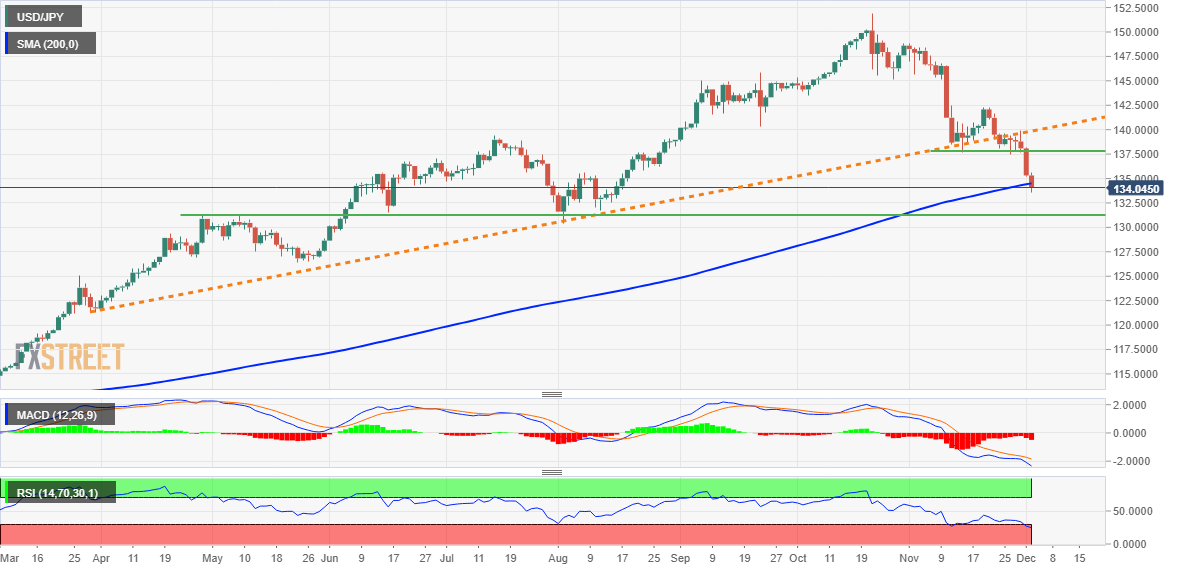
Key levels to watch
- EUR/USD advances further to fresh 6-month peaks near 1.0550.
- Further upside could put the 1.0614 level back on the radar.
EUR/USD keeps the optimism well and sound and advances to new highs near 1.0550, an area last seen back in late June.
Gains in the pair are now likely to pick up pace following the breakout of the 200-day SMA and the 10-month resistance line. Against that, there are no resistance levels of note until the June high at 1.0614 (June 27).
Further upside in EUR/USD remains on the cards while above the 200-day SMA, today at 1.0365.
EUR/USD daily chart
- The index sheds further ground and retreats to multi-month lows.
- Further weakness could force the dollar to test the 103.40 zone.
DXY loses ground for the third session in a row and re-visits the 104.30 area on Friday.
The continuation of the selling pressure could motivate the dollar to accelerate losses and challenge the weekly low at 103.67 (June 27) ahead of another weekly low at 103.41 (June 16).
Below the 200-day SMA at 105.51, the dollar’s outlook should remain negative.
DXY daily chart

USD/JPY is approaching potential support zone at 132.50/130.40. The downtrend could extend on failure to hold this support, economists at Société Générale report.
Graphical level at 145 could contain upside
“The pair is fast approaching its next potential support of 132.50, representing the 38.2% retracement of the whole uptrend since 2020. The low formed in August at 130.40 is an important support level. A test of this support could result in a short-term bounce; however, a graphical level at 145 could contain upside.”
“If the pair fails to defend support at 130.40, the downtrend is likely to extend towards 127.30 and 2015 levels of 125.85/124.00.”
European Central Bank (ECB) Vice President Luis de Guindos said on Friday that the economic deceleration in the Eurozone will not be as deep as expected a few weeks ago, as reported by Reuters.
Key takeaways
"Inflation data in November has been good news."
"Inflation in eurozone around mid-2023 will hover around 7%."
"Further interest rate increases will depend on upcoming data."
"We are seeing that inflation is starting to slow down."
Market reaction
The EUR/USD pair showed no immediate reaction to these comments and was last seen trading at 1.0535, rising 0.14% on a daily basis.
EUR/USD maintains gains above 1.05. Economists at Scotiabank expect the pair to extend its advance toward the 1.0650/1.0750 range.
Technical trend remains bullish
“EUR/USD remains well-supported near the high of the week and looks well-positioned to advance a little more at least in the near term as broader USD sentiment weakens.”
“A weekly close above 1.0517 (50% retracement of the 2022 decline) should be sufficient to push EUR gains on the 1.0650/1.0750 range.”
“Trend signals are aligned bullishly on short, medium and long-term oscillators which should limit counter-trend corrections (to the high 1.04s) and keep the EUR grind higher on track for more gains.”
Canadian employment details overview
Statistics Canada is scheduled to publish the monthly employment report for November later this Friday at 13:30 GMT. The Canadian economy is anticipated to have added 5K jobs during the reported month, down sharply from October's blockbuster reading of 108.3K. Moreover, the unemployment rate is anticipated to edge higher from 5.2% to 5.3% in November.
According to analysts at NBF: “The prior month’s report was suspiciously strong (+108.3K) given slowing growth and declining business confidence. A trend reversal would therefore not be surprising; we expect employment to have fallen 25K in the penultimate month of 2022. Such a decline would translate into a two-tick increase in the unemployment rate to 5.4%, assuming the participation rate remained steady at 64.9% and the working-age population grew at a strong pace.”
How could the data affect USD/CAD?
The data is more likely to be overshadowed by the simultaneous release of the closely-watched US jobs report - popularly known as NFP. That said, a significant divergence from the expected readings might still influence the Canadian Dollar and provide some meaningful impetus to the USD/CAD pair.
Strong domestic data should provide a goodish lift to the Canadian dollar and exert fresh downward pressure on the USD/CAD pair. Conversely, any disappointment from the Canadian jobs data is more likely to be overshadowed by the prevalent US Dollar selling bias amid bets for a less aggressive policy tightening by the Fed. This, in turn, suggests that the path of least resistance for the major is to the downside any positive reaction is more likely to get sold into.
From current levels, the 1.3400 mark is likely to protect the immediate downside ahead of a two-week-old ascending trend-line support, around the 1.3380 region. A convincing break below the latter will be seen as a key trigger for bears and expose the crucial 100-day SMA support, currently around the 1.3300-1.3290 region.
On the flip side, momentum beyond the overnight swing high, around the 1.3470 region, is likely to confront stiff resistance and remain capped near the 1.3500 psychological mark. That said, some follow-through strength might prompt some short-covering move and lift the USD/CAD pair towards the 1.3575-1.3580 hurdle en route to the 1.3600 mark.
Key Notes
• Canadian Jobs Preview: Forecasts from five major banks, more lackluster performance
• USD/CAD Outlook: Traders seem non-committed ahead of US NFP, Canadian jobs data
• USD/CAD Price Analysis: Impending bear cross keeps sellers hopeful above 1.3400
About the Employment Change
The employment Change released by Statistics Canada is a measure of the change in the number of employed people in Canada. Generally speaking, a rise in this indicator has positive implications for consumer spending which stimulates economic growth. Therefore, a high reading is seen as positive, or bullish for the CAD, while a low reading is seen as negative or bearish.
About the Unemployment Rate
The Unemployment Rate released by Statistics Canada is the number of unemployed workers divided by the total civilian labour force. It is a leading indicator for the Canadian Economy. If the rate is up, it indicates a lack of expansion within the Canadian labour market. As a result, a rise leads to weaken the Canadian economy. Normally, a decrease of the figure is seen as positive (or bullish) for the CAD, while an increase is seen as negative or bearish.
- EUR/JPY breaks below the 141.00 mark to record new 3-month lows.
- Extra losses now target the key 200-day SMA just above 139.00.
EUR/JPY remains entrenched in the negative territory and drops to new 3-month lows in the 140.80/75 band at the end of the week.
The sharp pullback breached the 4-month support line and left the cross vulnerable to a deeper decline. Against that, the next support of relevance is expected at the critical 200-day SMA, today at 139.08.
The outlook for EUR/JPY is expected to remain positive while above this region.
EUR/JPY daily chart
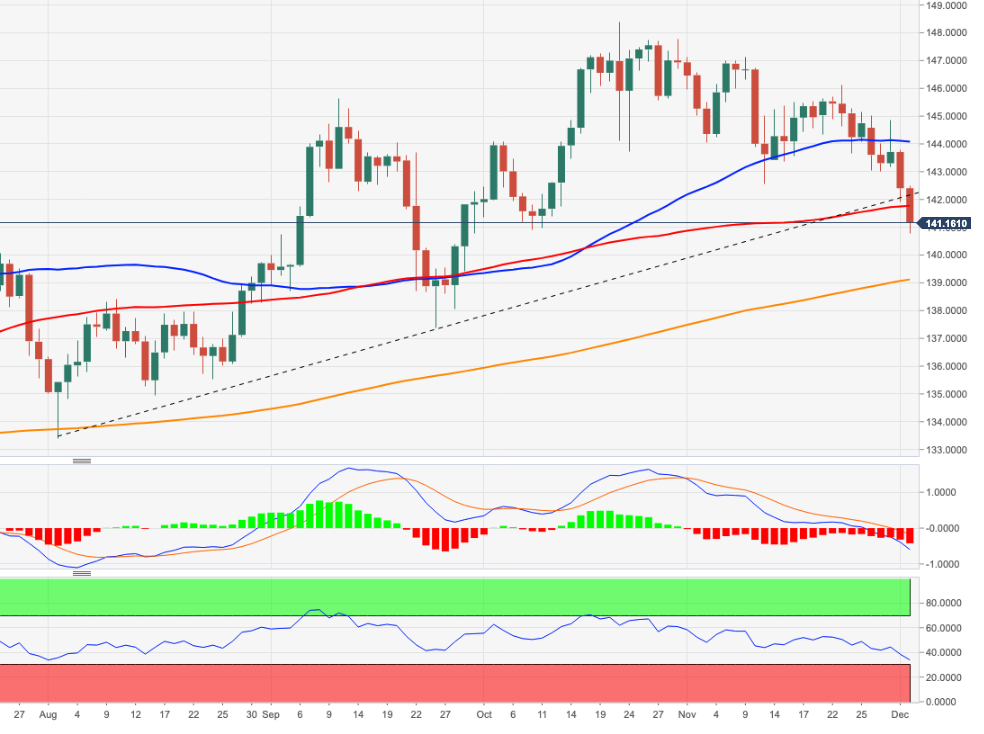
What will China’s reopening mean for the US? Here is what economists at Morgan Stanley think you need to know.
Fed will be able to slow and eventually pause its rate hikes in 2023
“China's restrictive COVID zero policy will be a thing of the past come spring of 2023, but there will be many fits and starts along the way. This dynamic is important to understand for its implications to the outlook for the global economy and key markets.”
“The economic growth story for Asia should be weak in the near term, but begin to improve and outperform the rest of the world from the second quarter of 2023 through the balance of the year.”
“In the US, the reopening of the China economy should help ease inflation as the supply of core goods picks up with supply chains running more smoothly. This, in turn, supports the notion that the Fed will be able to slow and eventually pause its rate hikes in 2023.”
“Look to the foreign exchange markets. China's currency should relatively benefit, particularly if reopening leads investors back to its equity markets. The US Dollar, however, should peak, as the Fed approaches pausing its interest rate hikes and, accordingly, ceasing the increase in the interest rate advantage for holding USD assets versus the rest of the world.”
Lee Sue Ann, Economist at UOB Group, sees the RBA raising the OCR by 25 bps at its event next week.
Key Takeaways
“Both consumer and business confidence have softened under the weight of high inflation and rising interest rates. This is why we think the RBA will soon pause in the current rate hiking cycle.”
“We are penciling in another 25bps hike at the final monetary policy meeting of the year on 6 Dec, which will take the OCR to 3.10%. Thereafter, we look for a hold.”
GBP/USD has risen close to the 1.2450 mark. A break above here is needed to avoid a phase of pullback, economists at Société Générale report.
Watch out for next hurdle at 1.2450
“1.2450 is the lower end of the multi-year range from which the pair broke down earlier this year and it is expected to be an intermittent resistance zone. A test and failure to cross above this hurdle could result in a phase of pullback. The October high of 1.1500, which is also the 50DMA, is expected to be first layer of support in case a decline develops.”
“If the pair establishes itself beyond 1.2450, the up move could extend towards 1.2750, the 61.8% retracement from February 2021 and 1.3250/1.3300.”
US monthly jobs report overview
Friday's US economic docket highlights the release of the closely-watched US monthly jobs data for November. The popularly known NFP report is scheduled for release at 13:30 GMT and is expected to show that the economy added 200K jobs during the reported month, down from the 261K in October. The unemployment rate is anticipated to hold steady at 3.7% in November. Apart from this, investors will take cues from Average Hourly Earnings, which could offer fresh insight into the possibility of any further rise in inflationary pressures.
Analysts at Citibank are more optimistic and offer a brief preview of the important macro data: “We expect a solid 225K jobs added in November, reflecting a slowing but still-solid pace of job growth. Average hourly earnings should rise 0.3% MoM, a slightly softer increase than last month but with upside risks. Average hourly earnings have slowed in recent months relative to other, more carefully constructed wage measures such as the Atlanta Fed’s Wage Tracker and the Fed’s preferred Employment Cost Index. After a somewhat surprising increase in October, we expect the unemployment rate to drop to 3.6%.”
How could the data affect EUR/USD?
Ahead of the key release, the US Dollar plummets to over a five-month low in the wake of a dovish pivot by the Fed and assists the EUR/USD pair to hold steady above the 1.0500 psychological mark. Weaker US employment details should be enough to trigger a fresh leg down in the USD and provide an additional boost to the major.
In contrast, any positive surprise - though could offer a temporary respite to the USD - is likely to be overshadowed by expectations that the US central bank will slow the pace of its rate-hiking cycle. This, in turn, favours the USD bears and suggests that the path of least resistance for the EUR/USD pair is to the upside.
Eren Sengezer, Editor at FXStreet, offers a brief technical overview and outlines important technical levels to trade the EUR/USD pair: “The Relative Strength Index (RSI) indicator on the four-hour chart stays within a touching distance of 70, suggesting that the pair could stage a technical correction before the next leg higher. On the upside, interim resistance seems to have formed at 1.0540. In case buyers manage to flip that level into support, additional gains toward 1.0600 (psychological level, static level) and 1.0630 (static level) could be witnessed.”
“1.0500 (former resistance, psychological level) aligns as initial support. With a four-hour close below that level, sellers could take action and drag the pair toward the 1.0410/1.0390 area, where the 20-period and the 50-period Simple Moving Averages are located,” Eren adds further.
Key Notes
• Nonfarm Payrolls Preview: Dollar selling opportunity? Low expectations to trigger temporary bounce
• US NFP Preview: Forecasts from 10 major banks, less strong, but not weak
• EUR/USD Forecast: Euro to end week on strong note on weak NFP
About the US monthly jobs report
The nonfarm payrolls released by the US Department of Labor presents the number of new jobs created during the previous month, in all non-agricultural business. The monthly changes in payrolls can be extremely volatile, due to its high relation with economic policy decisions made by the Central Bank. The number is also subject to strong reviews in the upcoming months, and those reviews also tend to trigger volatility in the forex board. Generally speaking, a high reading is seen as positive (or bullish) for the USD, while a low reading is seen as negative (or bearish), although previous month's reviews and the unemployment rate are as relevant as the headline figure.
- USD/CAD struggles for a firm direction on Friday and remains confined in a narrow range.
- Traders now await the release of the monthly employment data from the US and Canada.
- Bearish traders might wait for sustained weakness below the 1.3385 confluence support.
The USD/CAD pair extends its sideways consolidative price moves through the mid-European session and remains confined in a narrow trading band below mid-1.3400s.
The US Dollar selling remains unabated on the last day of the week amid growing acceptance that the Fed will slow the pace of its rate-hiking cycle. This, in turn, continues to cap the USD/CAD pair, though a modest downtick in oil prices undermines the commodity-linked Loonie and acts as a tailwind. Traders also seem reluctant to place aggressive bets ahead of the monthly employment reports from the US and Canada.
From a technical perspective, the USD/CAD pair, so far, has managed to hold above the 1.3400 mark and the 100-period SMA on the 4-hour chart. The latter, currently pegged around the 1.3385 area, coincides with over a two-week-old ascending trend-line extending from the November swing low and should now act as a pivotal point. A convincing break below will be seen as a key trigger for bears and set the stage for further losses.
The subsequent downfall will expose the crucial 100-day SMA support, currently around the 1.3300-1.3290 region. Some follow-through selling should pave the way for an extension of the recent sharp pullback from a 29-month peak touched in October.
On the flip side, the overnight swing high, around the 1.3470 zone, might act as an immediate barrier ahead of the 1.3500 psychological mark. A sustained strength beyond the latter could lift the USD/CAD pair towards the 1.3575-1.3580 hurdle en route to the 1.3600 mark and the multi-week high, around the 1.3645 zone set on Tuesday.
USD/CAD 4-hour chart
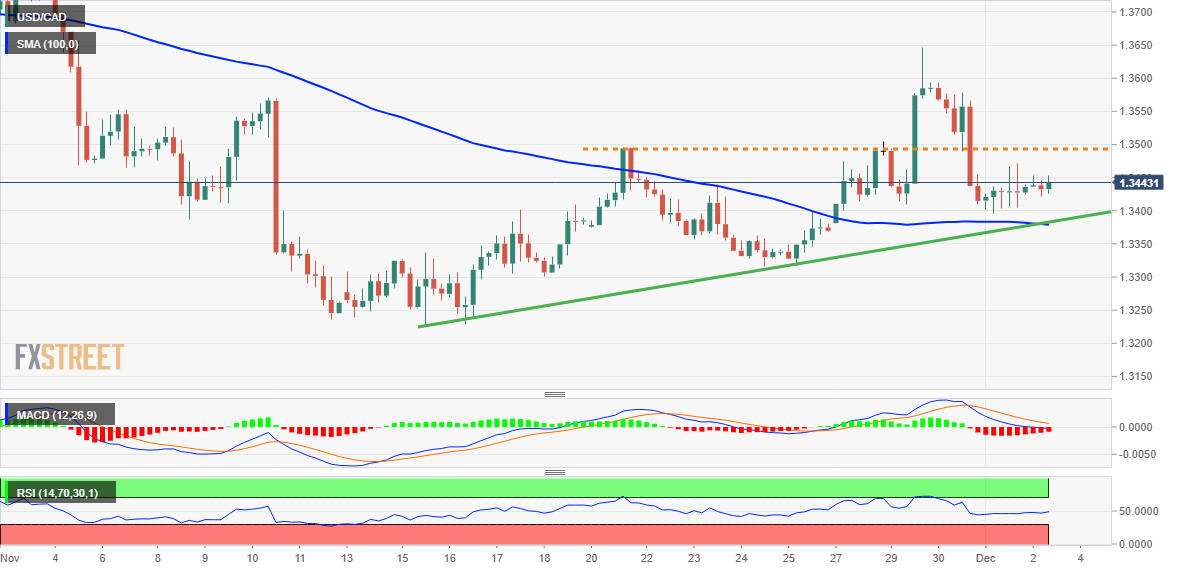
Key levels to watch
EUR/USD is extending its bounce. The pair could enjoy further gains on a move beyond the 1.0630/1.0690 region, economists at Société Générale report.
Graphical levels of 1.0000/0.9930 should be an important support
“A test of projections at 1.0630/1.0690, which is also the low of March 2020 and the descending trend line connecting highs of June 2021 and February 2022, is expected. This is likely to act as an interim resistance zone. In case the up-move falters near this hurdle, a short-term pullback is expected to materialise.”
“Graphical levels of 1.0000/0.9930 should be an important support zone. Failure to defend this could mean renewed downward momentum.”
USD/JPY has broken below 135.00. A dip under the 134.50 mark is set to trigger another leg lower, economists at ING report.
Markets may struggle to live with sub-3.50% rates for long
“The main risk for USD/JPY is that UST 10Y yields fail to find extra support at 3.50%: a further bond rally could force a break below the 134.50 200-Day Moving Average and unlock additional downside potential for USD/JPY.”
“Still, markets may struggle to live with sub-3.50% rates for long in the current environment.”
10-year Yields have plummeted 76 bps from their high of 4.335%. Support must come quickly to avoid yields unraveling below 3.50%, economists at Société Générale report.
Signals of a meaningful up move are not yet visible
“Signals of a meaningful up move are not yet visible; failure to reclaim the peak formed earlier this week near 3.80% can lead to continuation in pullback.”
“Below 3.50%, next objectives are located at 3.38% and the lower band of the channel at 3.25%/3.20%.”
See: US 10Y Bond Yields could move below 3.00% – Credit Suisse
EUR/USD closed above 1.0500 for the first time since June. Economists at ING note that the pair could test the 1.0600 level.
Ignoring some warning signs
“EUR/USD moves should only be a function of the market’s reaction to US payrolls today. There is a non-negligible risk we explore 1.0600, with the pair not having any clear resistance levels until the 1.0780 6-month highs. We are, however, getting the feeling that markets are ignoring at least one warning sign for the Euro.”
“TTF contracts are trading at one-month highs now and may see further upside volatility in the near term as temperatures in northern Europe are expected to fall. A significant recovery in gas prices would likely make the recent rally in EUR/USD unsustainable.”
The more nuanced approach to monetary policy going forward suggested by Fed Chair Powell’s speech means the jobs reports in the coming months will be even more important. Economists at MUFG Bank note that impressively strong Nonfarm Payrolls figures are needed to lift the US Dollar.
Jobs data increasingly important
“When Fed Chair Powell talks of avoiding ‘crashing the economy’ what the Fed really wants to engineer is a soft landing that means the scale of unemployment increase is kept to the minimum required to achieve a drop in inflation back to target. Hence, the importance of NFP reports.”
“Given the momentum in the market favouring USD selling, we suspect a weaker than expected employment report would trigger a bigger market reaction than a stronger than expected report.”
“It would take less of a surprise we feel for the market to price in less tightening from the FOMC than more. So the bias feels skewed to a weaker Dollar today and a stronger jobs report would have to be impressively stronger to see the US Dollar advance notably.”
See – US NFP Preview: Forecasts from 10 major banks, less strong, but not weak
US Dollar Index (DXY) has now lost 8.5% from the top in October and is below the August low of 104.60. Economists at Société Générale highlight the next targets on the downside.
An initial bounce is on the cards
“Daily MACD is within deep negative territory pointing towards an overstretched move. An initial bounce is not ruled out, however, the recent pivot high at 107.20/108.00 could provide resistance near term.”
“Next potential supports are located at 2020 peak of 103 and 101.90/101.30, the 50% retracement from 2021.”
- GBP/USD oscillates in a narrow trading band just below its highest level since June.
- The overnight breakout above the 200-day SMA supports prospects for further gains.
- Bulls, however, prefer to wait for the crucial US NFP report before placing fresh bets.
The GBP/USD pair consolidates its recent gains to the highest level since June and oscillates in a range, below the 1.2300 mark through the first half of the European session on Friday. The technical bias, meanwhile, remains tilted in favour of bulls and supports prospects for a further near-term appreciating move.
The overnight sustained strength and acceptance above a technically significant 200-day SMA for the first time in 2022 could be seen as a fresh trigger for bullish traders. Furthermore, the recent move up since late September has been along an ascending channel, which further points to a well-established short-term positive trend.
Moreover, oscillators on the daily chart are holding comfortably in the positive territory and are still far from being in the overbought zone. The GBP/USD pair, however, remains capped near the trend-channel resistance as traders prefer to move to the sidelines ahead of the release of the closely-watched US monthly jobs report (FMP).
Hence, it will be prudent to wait for a sustained strength beyond the top end of the aforementioned channel before placing fresh bullish bets. The said barrier is currently pegged near the 1.2310 region, above which the GBP/USD pair could climb to the 1.2345-1.2350 intermediate resistance and eventually aim to reclaim the 1.2400 round-figure mark.
On the flip side, the corrective pullback might now find decent support near the 1.2200 mark. Any further downfall could be seen as a buying opportunity and remain limited near the 1.2150 region (200-DMA). The latter should act as a pivotal point for short-term traders, which if broken decisively will negate the near-term positive outlook for the GBP/USD pair.
GBP/USD daily chart

Key levels to watch
Economist at UOB Group Enrico Tanuwidjaja reviews the latest interest rate decision by the Bank of Thailand.
Key Takeaways
“BOT voted unanimously to raise the policy rate by 25bps to 1.25%. This is its third hike for 2022. Back in Aug when BOT started its hiking cycle, 1 out of a total 7 members preferred a larger 50bps hike.”
“BOT deemed that a gradual policy normalization remains an appropriate course for monetary policy given the growth and inflation outlook in today’s decision statement.”
“We revised our view for another two 25bps back-to-back rate hikes to 1.75% in 2023 Jan and Mar MPC meeting and remained at that level for the rest of next year.”
- EUR/USD clinches fresh 6-month tops near 1.0550 on Friday.
- Germany’s trade surplus widened to €6.9B in October.
- US Nonfarm Payrolls will take centre stage later in the session.
The European currency now comes under some mild pressure and motivates EUR/USD to retreat to the 1.0520 region following earlier peaks near 1.0550 on Friday.
EUR/USD alternates gains with losses ahead of US data
EUR/USD now struggles to keep the strong weekly rebound well and sound above the 1.0500 hurdle soon after hitting new 6-month highs near 1.0550.
In the meantime, the continuation of the decline in the dollar continues to underpin the upbeat momentum in the pair, which gathered extra steam after surpassing the critical 200-day SMA (1.0365) and the 10-month line around 1.0410.
The daily improvement in the pair is also accompanied by another decline in the German 10-year bund yields, this time breaking below the 1.80% level, an area last seen back in early October.
Earlier in the domestic docket, Germany’s trade surplus increased to €6.9B in October (from €3.7B).
Moving forward, the release of the US Nonfarm Payrolls for the month of November (200K exp.) will take centre stage seconded by the Unemployment Rate (3.7% exp.). In addition, Chicago Fed C.Evans is also due to speak.
What to look for around EUR
EUR/USD manages to extend the rally to the vicinity of 1.0550, or multi-month peaks, amidst persistent optimism in the risk complex and intense weakness in the dollar ahead of US Payrolls.
In the meantime, the European currency is expected to closely follow dollar dynamics, the impact of the energy crisis on the region and the Fed-ECB divergence. In addition, markets repricing of a potential pivot in the Fed’s policy remains the exclusive driver of the pair’s price action for the time being.
Back to the euro area, the increasing speculation of a potential recession in the bloc emerges as an important domestic headwind facing the euro in the short-term horizon.
Key events in the euro area this week: ECB Lagarde, Germany Balance of Trade (Friday).
Eminent issues on the back boiler: Continuation of the ECB hiking cycle vs. increasing recession risks. Impact of the war in Ukraine and the persistent energy crunch on the region’s growth prospects and inflation outlook. Risks of inflation becoming entrenched.
EUR/USD levels to watch
So far, the pair is losing 0.05% at 1.0520 and a breach of 1.0365 (200-day SMA) would target 1.0330 (weekly low November 28) en route to 1.0222 (weekly low November 21). On the upside, there is an initial hurdle at 1.0548 (monthly high December 2) ahead of 1.0614 (weekly high June 27) and finally 1.0773 (monthly high June 27).
With a larger yield top now threatening in the US 10-year Bond Yield, economists at Credit Suisse downgrade their tactical objective further to 3.045/00%.
10yr US Bond Yields to confirm a large top on a break below 3.56%
“10yr US Bond Yields need to break below 3.56% to confirm a larger top. Of course, Nonfarm Payrolls data represents a key event risk, however, short-term momentum continues to accelerate to the downside, suggesting a break is more likely than not.”
“Even if yields were to rebound from current levels on an upside NFP surprise, the completion of a larger top would still be our base case, as long as the market holds below support at 4.00/03%.”
“Assuming the top is confirmed, the potential ‘measured top objective’ suggests a move below 3.00% is possible, however, the rising 200-Day Average at 3.045% should provide a formidable barrier beforehand.”
See – US NFP Preview: Forecasts from 10 major banks, less strong, but not weak
UOB Group’s Economist Lee Sue Ann and Markets Strategist Quek Ser Leang note a deeper decline in USD/CNH could see the 7.000 level revisited in the near term.
Key Quotes
24-hour view: “We highlighted yesterday that USD ‘could test 7.0200 first before the risk of a rebound increases’. Our expectations did not materialize as USD traded within a range of 7.0256/7.0919 before closing slightly lower at 7.0390 (-0.11%). The price movement is likely part of a consolidation phase and we expect USD to trade within a range of 7.0300/7.0800 today.”
Next 1-3 weeks: “We continue to hold the same view as yesterday (01 Dec, spot at 7.0400). As highlighted, the recent outsized drop in USD is likely to extend to 7.0200, possibly below 7.0000. The downside risk is intact as long USD does not move above 7.1250 (‘strong resistance’ level was at 7.1400 yesterday).”
GBP/USD has gone into a consolidation phase at around 1.2250. Economists at ING expect the pair to plummet toward 1.1500 by year-end.
Cable nearing the peak?
“US Nonfarm Payrolls may fail to invert the bearish Dollar trend and GBP/USD may find a bit more support around 1.2300-1.2350.”
“However, Cable is not factoring in the negative implications of rebounding gas prices and weak economic fundamentals. A return to 1.1500 around the turn of the year seems appropriate in our view.”
See – US NFP Preview: Forecasts from 10 major banks, less strong, but not weak
- AUD/USD gains some positive traction for the fourth straight day amid sustained USD selling.
- The Fed’s dovish pivot continues to drag the US bond yields lower and weigh on the greenback.
- A softer risk tone seems to act as a headwind for the risk-sensitive Aussie ahead of the NFP report.
The AUD/USD pair reverses an intraday dip to sub-0.6800 levels and turns positive for the fourth successive day on Friday. The steady intraday ascent extends through the first half of the European session and lifts spot prices to the 0.6835 region, back closer to the highest level since September 13 touched on Thursday.
The US Dollar selling remains unabated amid rising bets for a less aggressive policy tightening by the Fed, which, in turn, acts as a tailwind for the AUD/USD pair. The dovish-sounding comments by Fed Chair Jerome Powell, along with signs of easing inflationary pressures, reaffirmed expectations that the US central bank will slow the rate-hiking cycle. This is evident from slugging US Treasury bond yields and continues to weigh on the greenback.
Furthermore, hopes of more stimulus from China and the easing of stringent COVID-19 restrictions in the world's second-largest economy offer additional support to the China-proxy Australian Dollar. That said, the cautious market mood could act as a headwind for perceived riskier currencies and keep a lid on any further gains for the AUD/USD pair. Traders also seem reluctant to place aggressive bets ahead of the US monthly employment details.
The popularly known NFP report is due later during the early North American session and will provide fresh insight into the US labour market. This might influence the Fed's policy outlook and drive the USD demand ahead of the next FOMC meeting on December 13-14. Apart from this, the broader market risk sentiment should provide some impetus to the AUD/USD pair. Nevertheless, spot prices seem poised to post gains for the second straight week.
Technical levels to watch
- The index drops to 6-month lows near 104.50 on Thursday.
- Further losses remain likely after a breakdown of the 200-day SMA.
- US Nonfarm Payrolls are expected at 200K in November.
The USD Index (DXY), which tracks the greenback vs. a bundle of its main competitors, remains well on the defensive and revisits multi-month lows around 104.50 at the end of the week.
USD Index looks at Payrolls
The index loses ground for the third session in a row on Friday and drops to levels last seen back in late June near 104.40, always in response to the increasingly deteriorated outlook for the greenback and the pick-up in the sentiment surrounding the risk-associated universe.
The rapid decline in the index has been exacerbated as of late and especially in response to Chair Powell’s speech on Wednesday, where he once again reiterated that a moderation in the pace of future interest rate hikes looks appropriated.
The march lower in the dollar comes in tandem with the absence of direction in US yields across the curve, which seem to have met some initial contention in recent multi-week lows.
Later in the NA session, all the attention will be on the release of the Nonfarm Payrolls for the month of November (200K exp.) and the Unemployment Rate (3.7% exp.), all ahead of the speech by Chicago Fed C.Evans (2023 voter, centrist).
What to look for around USD
The dollar extends the downside and revisits multi-month lows near 104.30 ahead of the key release of the US jobs report for the month of November.
While hawkish Fedspeak maintains the Fed’s pivot narrative in the freezer, upcoming results in US fundamentals would likely play a key role in determining the chances of a slower pace of the Fed’s normalization process in the short term.
Key events in the US this week: Nonfarm Payrolls, Unemployment Rate (Friday).
Eminent issues on the back boiler: Hard/soft/softish? landing of the US economy. Prospects for further rate hikes by the Federal Reserve vs. speculation of a recession in the next months. Fed’s pivot. Geopolitical effervescence vs. Russia and China. US-China persistent trade conflict.
USD Index relevant levels
Now, the index is retreating 0.24% at 104.48 and the breakdown of 103.41 (weekly low June 16) would pave the way for a test of 101.29 (monthly low May 30) and finally 100.00 (psychological level). On the other hand, the immediate resistance emerges at 105.55 (200-day SAM) followed by 107.19 (weekly high November 30) and then 107.99 (weekly high November 21).
The Bank of Japan (BoJ) bought JPY70.1 billion ($523.37 million) of exchange-traded funds (ETFs) on Friday, according to the central bank data.
The BoJ stepped into the market for the first time in six months afte the Japanese indices fell roughly 2% on Friday.
Irish Minister for Foreign Affairs and Defence, Simon Coveney, said on Friday, “trust is growing in protocol negotiations between the UK and Northern Ireland.”
“Landing zone on the protocol is possible in the next few weeks,” Coveney added.
His comments come a day after the European Commission's President Ursula von der Leyen said she has had "encouraging" meetings with Rishi Sunak over the Northern Ireland Protocol and is "very confident" a solution can be found.
Market reaction
GBP/USD is benefiting from the renewed selling in the US Dollar and the upbeat Brexit headlines, adding 0.26% on the day to trade at 1.2283, at the press time.
Today, the Bank of Canada will gain further important insight for next week’s rate decision with the labour market report for November. If the data surprises on the upside, the Loonie could surge higher, economists at Commerzbank report.
Continued constraints on the labour market?
“If today’s data remains within the framework of expectations (unemployment rate 5.3%; employment +10K) it should not impress the Loonie much. With a view to the BoC meeting next week the market seems to be expecting a smaller rate step of 25 bps.”
“The analysts polled by Bloomberg are divided. Whereas one half also expects BoC to switch down a gear, the other half expects it to hike its key rate by a further 50 bps. Against this background, a surprisingly strong labour market might well drive rate expectations up again, which would support the Loonie.”
See – Canadian Jobs Preview: Forecasts from five major banks, more lackluster performance
Further decline in USD/JPY is predicted to meet the next solid support at 134.00, comment UOB Group’s Economist Lee Sue Ann and Markets Strategist Quek Ser Leang.
Key Quotes
24-hour view: “Yesterday, we indicated that ‘The strong downward momentum in USD is likely to continue’. We added, ‘The support levels to monitor are at 136.40 and 135.50’. USD took out both support levels as it plunged to a low of 135.20 in NY trade. While further weakness is not ruled out, the massive drop over the past couple of days is overextended and it remains to be seen if USD could challenge the next support at 134.00 today. Resistance is at 135.90, a breach of 136.50 would indicate that the weakness in USD has stabilized.”
Next 1-3 weeks: “We indicated yesterday (01 Dec, spot at 137.20) that the strong surge in downward momentum is likely to lead to further USD weakness to 136.40, as low as 135.50. While our view was correct, we did not quite expect 135.50 to come view so soon as USD nose-dived to a low of 135.20. Downward momentum is unsurprisingly, still strong but it is left to be seen if USD could maintain the frenetic pace of decline. The next level to watch is at 134.00. On the upside, a breach of 137.05 (‘strong resistance’ level was at 138.55 yesterday) would indicate that the weakness in USD has stabilized.”
- USD/JPY drops to a fresh multi-month low on Friday amid sustained USD selling bias.
- The Fed’s dovish pivot and sliding US bond yields continue to weigh on the greenback.
- Technical selling below the 135.00 mark also contributes to the downward trajectory.
- Oversold conditions on short-term charts could help limit losses ahead of the US NFP.
The USD/JPY pair remains under some selling pressure for the fifth straight day and drops to its lowest level since August 17 during the early part of the European session on Friday. The pair is currently trading just below mid-134.00s, down over 0.50% for the day, with bears awaiting a convincing break through the very important 200-day SMA.
The prevalent bearish sentiment surrounding the US Dollar - amid expectations that the Fed will soften its policy stance - is seen as a key factor dragging the USD/JPY pair lower. The prospects for a less aggressive policy tightening by the Fed were reaffirmed by dovish-sounding remarks by Fed Chair Jerome Powell and signs of easing inflationary pressures. This, in turn, keeps the US Treasury bond yields depressed and continues to weigh on the greenback.
In fact, the yield on the benchmark 10-year US government drops to a nearly two-month low, narrowing the US-Japan rate differential. Apart from this, the overnight hawkish-sounding comments by Bank of Japan (BoJ) board member Asahi Noguchi continue to underpin the Japanese Yen and exert additional downward pressure on the USD/JPY pair. Noguchi hinted at the possibility of the pre-emptive withdrawal of stimulus if inflation overshoots expectations.
Furthermore, the latest leg down could also be attributed to some technical selling below the 135.00 psychological mark. That said, oversold conditions on short-term charts could lend some support to the USD/JPY pair, at least for the time being. Traders might also refrain from placing aggressive bets and prefer to move to the sidelines ahead of the closely-watched US jobs report, popularly known as NFP, due later during the early North American session.
Technical levels to watch
It is now evident that markets have operated a structural shift towards a bearish Dollar narrative. Today's US Nonfarm Payrolls may fall short of triggering an inversion of this trend, according to economists at ING.
USD downside risks persist
“Markets are approaching US NFP with a strong bearish rhetoric on the Dollar, and would likely jump on more risk-on (USD-negative) bets unless we see a convincingly strong payroll read.”
“The consensus is centred around 200K, and we forecast 220K, with the unemployment rate staying at 3.7%. Those numbers would be quite respectable and indicate that the jobs market has indeed remained extremely tight, but while it may halt the Dollar’s trend, it could fail to invert it.”
“All in all, the balance of risks appears slightly tilted to the downside for the Dollar today. A contraction in payrolls to 150K could generate a fresh round of large USD selling.”
See – US NFP Preview: Forecasts from 10 major banks, less strong, but not weak
Kiwi has seen move that has taken it through resistance at 0.6325. Next target on the upside aligns at 0.6450, economists at ANZ Bank report.
Large interest rate advantage for the Kiwi
“Kiwi has rallied strongly. This has come about mostly via a weaker USD (with the DXY at a fresh low for the cycle), but the NZD has also differentiated itself against the AUD, which we believe likely reflects its large interest rate advantage. That’s certainly a pillar of support (especially given the collapse in US bond yields).”
“Price action looks extremely solid, and technically, the next major target level is 0.6450 (marking both the Aug high and the 61.8% retracement of the whole 2022 move).”
Considering advanced prints from CME Group for natural gas futures markets, open interest rose for the third session in a row on Thursday, this time by around 2.5K contracts. On the other hand, volume shrank for the second straight session, now by almost 25K contracts.
Natural Gas could revisit $5.50 near term
Prices for the natural gas extended the leg lower on Thursday on the back of increasing open interest, which leaves the door open to the continuation of the ongoing retracement in the very near term. Against that, the commodity should meet contention around the November lows in the $5.50/60 region per MMBtu.
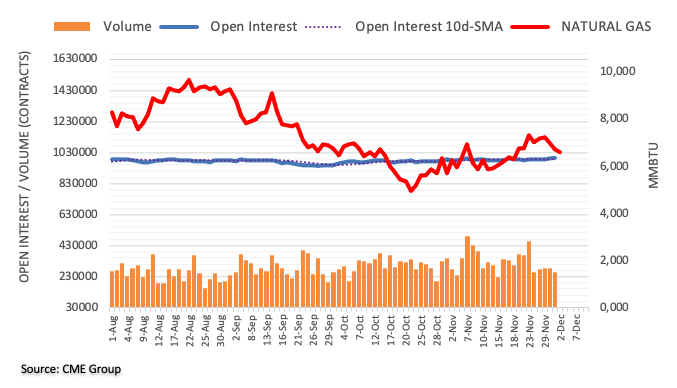
In the opinion of UOB Group’s Economist Lee Sue Ann and Markets Strategist Quek Ser Leang, AUD/USD could advance to 0.6915 once 0.6850 is cleared.
Key Quotes
24-hour view: “We expected AUD to ‘continue to advance’ yesterday. We added, ‘overbought conditions suggest 0.6850 could be out of reach today’. Our view turned out to be correct as AUD rose to 0.6847 before easing. Upward pressure has faded and the current price movement is likely part of a consolidation phase. Today, we expect AUD to trade between 0.6765 and 0.6845.”
Next 1-3 weeks: “Yesterday (01 Dec, spot at 0.6800), we indicated that the ‘rapid rise in AUD appears to be running ahead but there is room for AUD to rise further to 0.6850’. AUD subsequently rose to 0.6847 before easing off. Further AUD strength is not ruled out but it has to break clearly above 0.6850 before an advance to 0.6915 is likely. The likelihood of a clear break of 0.6850 would remain intact as long as AUD does not move below 0.6730 (‘strong support’ level was at 0.6715 yesterday).”
FX option expiries for Dec 2 NY cut at 10:00 Eastern Time, via DTCC, can be found below.
- EUR/USD: EUR amounts
- 1.0350 1.2b
- 1.0365 1.1b
- 1.0400 1.1b
- 1.0420 923m
- 1.0435 508m
- 1.0475 709m
- 1.0600 579m
- USD/JPY: USD amounts
- 135.00 478m
- 138.25 300m
- 138.65 300m
- 138.95 571m
- 140.00 510m
- AUD/USD: AUD amounts
- 0.6675 463m
- 0.6825 459m
- USD/CAD: USD amounts
- 1.3400 493m
- 1.3415 380m
- 1.3500 538m
- 1.3520 432m
- 1.3630 361m
- 1.3710 565m
- 1.3725 780m
- EUR/GBP: EUR amounts
- 0.8800 400m
Payrolls will be published in Canada today. An upside surprise will increase chances to see a 50 basis points hike by the Bank of Canada (BoC) next week, economists at ING report.
Jobs numbers quite key for BoC
“Consensus is centred around a very small 10K increase, and there is a high chance we could see a negative read. This would probably keep markets leaning in favour of a 25 bps rate hike by the BoC next week (currently, 30 bps are in the price). However, we see room for some upside surprise today in the jobs numbers and see a higher chance of another 50 bps by the BoC.”
“USD/CAD may soon re-test the 1.3290 100-Day Moving Average, but would require a more steady rebound in crude prices to keep the bearish momentum going.”
See – Canadian Jobs Preview: Forecasts from five major banks, more lackluster performance
- EUR/GBP gains some positive traction on Friday, though lacks follow-through buying.
- Bets for another supersized 75 bps ECB rate hike underpin the Euro and offers support.
- The GBP consolidates its recent gains and does little to provide any meaningful impetus.
The EUR/GBP cross attracts some buying on Friday and reverses a major part of the overnight slide to a three-month low, levels just below mid-0.8500s. The cross sticks to its modest gains through the early European session and is currently placed near the daily top, just above the 0.8600 mark.
The shared currency draws some support from European Central Bank President Christine Lagarde's remarks earlier this Friday, which, in turn, acts as a tailwind for the EUR/GBP cross. Lagarde reiterated the need to ensure that inflation returns to its goal. This comes on the back of her comments earlier this week that the region’s inflation has not peaked and favours another supersized 75 bps rate hike in December.
That said, softer-than-expected Eurozone consumer inflation figures released on Wednesday might have cooled expectations for more aggressive policy tightening by the Fed and might cap the Euro. In fact, the flash estimate published by Eurostat showed the annualized Eurozone Harmonised Index of Consumer Prices (HICP) recorded its first drop since mid-2021 and decelerated to a 10.0% YoY rate in November.
This, in turn, could act as a headwind for the Euro. The high beta British Pound, on the other hand, remains well supported by a generally positive risk tone and the prevalent US Dollar selling bias. The combination of aforementioned factors might keep a lid on any meaningful recovery move for the EUR/GBP cross, at least for the time being, warranting some caution for aggressive bullish traders.
Even from a technical perspective, the overnight breakdown below the 0.8575-0.8570 horizontal support favours bearish traders. That said, the emergence of some buying in the vicinity of the very important 200-day SMA makes it prudent to wait for strong follow-through selling before positioning for a further depreciating move.
Technical levels to watch
Open interest in crude oil futures markets shrank by round 5.7K contracts after two daily pullbacks in a row on Thursday, according to preliminary readings from CME Group. On the other hand, volume reversed two consecutive daily drops and went up by around 98.3K contracts.
WTI: Initial hurdle comes near $84.00
WTI prices rose for the third straight session on Thursday amidst shrinking open interest. Against that, the recent rebound in crude oil prices could lose strength and spark a corrective drop in the very near term. So far, the $84.00 mark per barrel appears as the immediate hurdle for bulls.
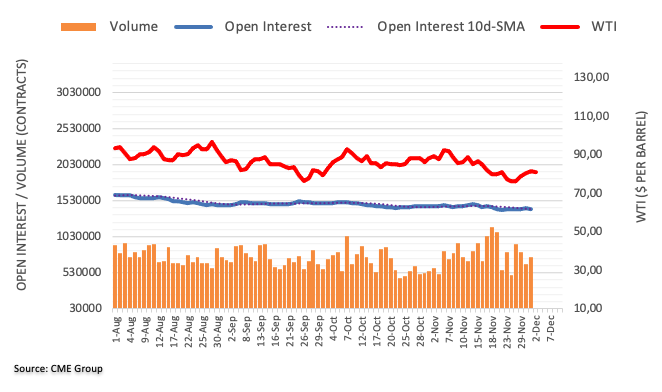
The subject of inflation is so yesterday on the FX market. Thus, US Dollar bears are set to remain at the helm even on a positive Nonfarm Payrolls report, economists at Commerzbank report.
The FX market is done with the subject of inflation
“If the November labour market report surprises on the upside, the last USD bulls might get up their hopes because wage inflation is then likely to be high again. However, the labour market is typically the market on which a reversal in inflation developments is last to be observed. That means that even in case of a positive surprise today the USD bears would not be forced to change their view.”
“Once again the FX market surprises me as regards the speed at which it anticipates future developments. Our 2023 projections of USD exchange rates are based on the assumption that the market is pricing out inflation concerns step by step. The biggest risk in my view is that this will happen much more quickly and that our EUR/USD target of 1.10 will be reached much more quickly than anticipated by us.”
See – US NFP Preview: Forecasts from 10 major banks, less strong, but not weak
The continuation of the upside momentum could lift GBP/USD to the 1.2400 region in the short term, suggest UOB Group’s Economist Lee Sue Ann and Markets Strategist Quek Ser Leang.
Key Quotes
24-hour view: “While our view for GBP to strengthen yesterday was correct, we did not expect the manner in which it jumped to a high of 1.2311 (we were of the view that it might not be able to hold above 1.2120). Today, we see room for another leg higher in GBP to 1.2350 before the risk of a pullback increases. The strong rally over the past couple of days appears to be overextended and GBP is unlikely to break the next resistance at 1.2400. On the downside, a break of 1.2185 (minor support is at 1.2225) would indicate that the rally in GBP is ready to take a breather.”
Next 1-3 weeks: “We indicated yesterday (01 Dec, spot at 1.2070) that ‘further GBP strength is likely but in order to keep the momentum going, it has to break 1.2155 within the next 1 to 2 days’. GBP not only took out 1.2155, but also a couple of other resistance levels as it rocketed to a high of 1.2311. Upward momentum is unsurprisingly, very strong, and GBP is likely to continue to advance. The next level to monitor is 1.2400. On the downside, a breach of 1.2130 (‘strong support’ was at 1.1960 yesterday) would indicate that the current strong upward pressure has eased.”
Canada’s employment data for November will be reported by Statistics Canada on Friday, December 2 at 13:30 GMT and as we get closer to the release time, here are forecasts from economists and researchers at five major banks regarding the upcoming jobs figures.
The North American economy is estimated to have created 5K jobs in November as against a massive jobs growth of 108.3K reported in October. The Unemployment Rate, however, is seen higher at 5.3% last month from October’s 5.2%.
TDS
“The labour market should see more modest gains with 12K jobs added in November to leave the UE rate steady at 5.2% while wage growth should soften a touch to 5.3% YoY.”
RBC Economics
“Though labour markets surged back in October, average employment growth still slowed to under 10K per month over the last half a year (following softer numbers in the summer and early fall). We are looking for a smaller 5Kposition increase in employment in November and a tick up in the unemployment rate (though to a still very low 5.3% rate from 5.2% in October).”
NBF
“The prior month’s report was suspiciously strong (+108.3K) given slowing growth and declining business confidence. A trend reversal would therefore not be surprising; we expect employment to have fallen 25K in the penultimate month of 2022. Such a decline would translate into a two-tick increase in the unemployment rate to 5.4%, assuming the participation rate remained steady at 64.9% and the working-age population grew at a strong pace.”
CIBC
“Employment surged in October, although with the size of the labour force doing the same the unemployment rate held steady. We forecast a modest gain in employment of 10K in November, which would be modestly below the pace of labour force growth and as such could see the jobless rate tick up to 5.3%.”
Citibank
“We expect a 15K decline in Canadian jobs in November. A return of strong immigration to Canada though could cause the unemployment rate to rise in November to 5.4%, as the labor force participation rate rises. But it would take a more substantial drop in November employment (more than 50K) to significantly raise the probability of a smaller 25 bps hike in December.”
CME Group’s flash data for gold futures markets noted traders increased their open interest positions for the first time since November 14 on Thursday, this time by around 12.7K contracts. Volume, followed suit and went up for the second session in a row, now by more than 33K contracts.
Gold now looks at $1,807
Thursday’s strong bounce in gold prices finally surpassed the key $1,800 mark per ounce troy. The move, in addition, was on the back of rising open interest and volume, which is indicative that further gains remain in store in the very near term. That said, the next target of note comes at the August high at $1,807 (August 10).
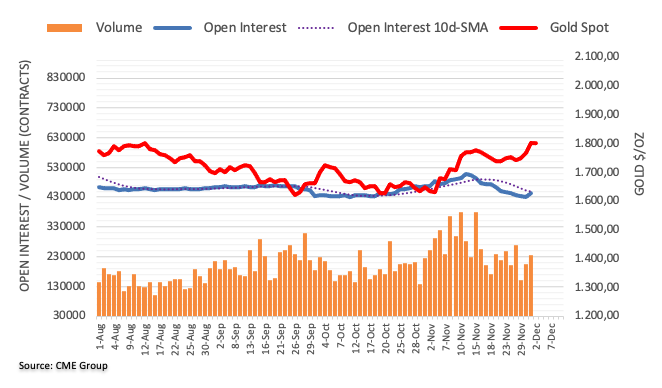
- USD/CAD remains indecisive after two-day downtrend, defends weekly gains.
- Federal Reserve policymakers’ dovish bias, softer United States data weigh US Dollar.
- Chatters surrounding China, Oil price cap on Russian exports test WTI bulls.
- Downbeat expectations from Canada, United States employment report tease Canadian Dollar buyers.
USD/CAD portrays the market’s indecision ahead of the monthly employment data from the United States and Canada during early Friday. In doing so, the Canadian Dollar fails to justify the retreat in the WTI crude oil, Canada’s key export item, amid a lackluster US Dollar. That said, the Loonie pair seesaws around 1.3430 by the press time, after a two-day downtrend.
Even if the USD/CAD pair remains inactive as of late, the hopes of slower rate hikes from the Federal Reserve (Fed) contrasts with the recently hawkish bias surrounding the Bank of Canada (BOC) to keep the bears hopeful. It’s worth noting that the looming Oil price cap from the Group of Seven (G7) nations and recovery in China’s Covid conditions hint at the further firming of Canada’s key earner, which in turn could weigh on the Loonie pair.
Federal Reserve policymakers contrast with Bank of Canada officials to favor USD/CAD bears
The dovish bias of the Federal Reserve (Fed) Chairman Jerome Powell, as well as downbeat comments from US Treasury Secretary Janet Yellen, initially raised hopes of easy rate hikes. Following that, Federal Reserve (Fed) Governor Michelle Bowman stated that (It is) appropriate for us to slow the pace of increases. Before him, Fed Governor Jerome Powell also teased the slowing of a rate hike while US Treasury Secretary Yellen also advocated for a soft landing. Further, Vice Chair of supervision, Michael Barr, also said, “We may shift to a slower pace of rate increases at the next meeting.” It’s worth noting that the recent comments from New York Fed’s John Williams seemed to have tested the US Dollar bears as the policymakers stated that the Fed has a ways to go with rate rises.
On the other hand, Bank of Canada (BOC) Governor Tiff Macklem testified in late November while saying, “We expect our policy rate will need to rise further.” Additionally, BOC’s Senior Deputy Governor Carolyn Rogers said, “It will take time to get back to solid growth with low inflation but we will get there.”
Differences between United States and Canada data also weigh on Loonie pair
On Thursday, United States Core Personal Consumption Expenditures (PCE) Price Index, the Federal Reserve’s preferred inflation gauge, matched 5.0% market forecasts on YoY but eased to 0.2% MoM versus 0.3% expected. Further, US ISM Manufacturing PMI for November eased to 49.0 versus 49.7 expected and 50.2 prior.
Earlier in the week, the US ADP Employment Change marked the lowest readings since January 2021 with 127K figure for November versus 200K forecast and 239K previous readings. Further, the second estimate of the US Gross Domestic Product (GDP) Annualized for the third quarter (Q3) marked 2.9% growth versus 2.6% initial forecasts.
Talking about Canada, Labor Productivity jumped to 0.6% in the third quarter (Q3) versus -0.1% expected and 0.1% prior (revised). Further, S&P Global Manufacturing PMI for November increased to 49.6 from 49.3 market expectations and 48.8 prior. Previously, Canada’s Gross Domestic Product Annualized for the third quarter (Q3) eased to 2.9% versus 3.5% expected and 3.2% (revised down) prior.
Oil buyers stay hopeful
WTI crude oil remains on the bull’s radar despite the latest retreat to $81.00. The reason could be linked to the comments from the Group of Seven Nations (G7) Price Cap Coalition, as well as hopes for China’s economic recovery.
Late on Thursday, Reuters quoted an Official from the G7 Price Cap Coalition as saying, “We are 'very very close' to agreement on $60-a- barrel price cap on Russian oil exports.” The diplomat also showed optimism about agreeing on refined products price cap by February 5.
Further, the consecutive three days of the downtrend of Chinese daily Covid infections from a record high allowed the policymakers to tease the “next stage” in battling the virus while announcing multiple easing of the activity-control measures.
Additionally, a likely inaction at this week’s meeting of the Organization of the Petroleum Exporting Countries and allies including Russia, known as OPEC+.
Considering Canada’s reliance on reliance on Crude Oil exports and likely hardships for the black gold supplies, as well as improvement in demand, the USD/CAD pair may witness further downside.
United States, Canada job numbers are the key
Given the likely downbeat outcome from both the Canadian and United States employment data, USD/CAD pair traders may try to find greater details and could react with more aggression in case of a surprise outcome.
That said, the headline US Nonfarm Payrolls (NFP) is likely to ease with a 200K print versus 261K prior while the Unemployment Rate could remain unchanged at 3.7%. It should be noted that a likely easing in the Average Hourly Earnings for the stated month could also weigh on the USD/CAD price.
On the other hand, Canada’s Net Change in Employment may decline to 5K versus 108.3K prior while the Unemployment Rate could increase to 5.3% from 5.2% previous readings.
USD/CAD technical analysis
Despite the latest inaction, the USD/CAD pair portrays a clear U-turn from the 50-DMA, as well as a downward-sloping resistance line from October 13, currently joining each other around 1.3570-75.
However, a failure to break a two-week-old ascending support line, near 1.3400 by the press time, keeps the Loonie pair buyers hopeful.
Even if the quote breaks the 1.3400 support line, a convergence of the 100-DMA and an ascending trend line from August 25, close to 1.3290 at the latest, appears a tough nut to crack for the USD/CAD pair sellers.
Alternatively, a clear upside break of the 1.3570-75 resistance confluence will need validation from the recent peak of 1.3645 to convince USD/CAD bulls.
Following that, a run-up towards the 23.6% Fibonacci retracement level of the Loonie pair’s August-October upside, near 1.3680, can’t be ruled out.
It should be noted that the USD/CAD pair’s advances past 1.3680 may witness a bumpy road around 1.3840 before the bulls could aim for the yearly high marked in October around 1.3980.
Overall, USD/CAD is likely to remain sidelined with a short-term downside bias.
USD/CAD: Daily chart
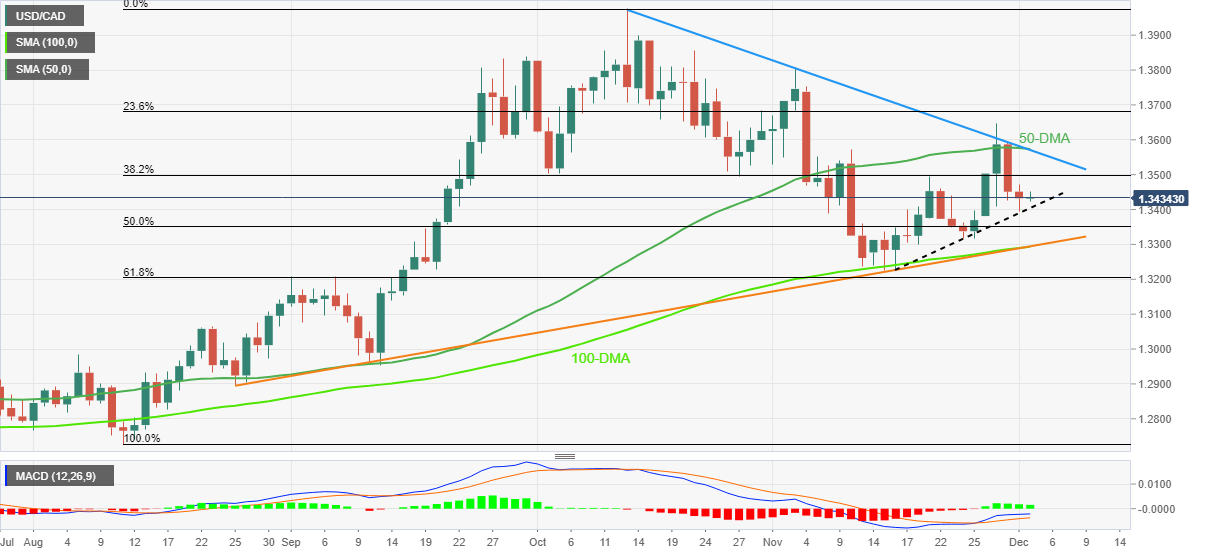
Trend: Limited downside expected
According to UOB Group’s Economist Lee Sue Ann and Markets Strategist Quek Ser Leang, EUR/USD now targets the 1.0620 level in the next few weeks.
Key Quotes
24-hour view: “We highlighted yesterday that ‘Further EUR strength is not ruled out but the major resistance at 1.0500 is unlikely to come into view today’. The anticipated advance exceeded our expectations as EUR surged to a high of 1.0533. While EUR could continue to advance and break the major resistance at 1.0550, the next resistance at 1.0620 is likely out of reach today. Support is at 1.0490, followed by 1.0460.”
Next 1-3 weeks: “We turned positive in EUR yesterday (01 Dec, spot at 1.0420) but we were of the view that ‘the solid resistance at 1.0500 might not be easy to break’. We did anticipate the rapid pace of advance as EUR continues to surge for the second day in a row and took out 1.0500 (high has been 1.0533). While deeply overbought, the rally is not showing signs of slowing and the risk remains on the upside. The next level to focus on is at 1.0620, followed by 1.0690. The upside risk is intact as long as EUR does not move below 1.0420 (‘strong support’ level was at 1.0330 yesterday).”
Here is what you need to know on Friday, December 2:
The US Dollar stayed under constant selling pressure following the macroeconomic data releases on Thursday and the US Dollar Index dropped to its lowest level since late June below 105.00. As investors await the November jobs report, the US Dollar struggles to stage a rebound. October Producer Price Index (PPI) will be featured in the European economic docket and Statistics Canada will publish the labor market report for November. Several Federal Reserve policymakers, including Richmond Fed President Thomas Barkin and Chicago Fed President Charles Evans, will be delivering speeches before the Fed blackout period starts on December 3.
Nonfarm Payrolls Preview: Dollar selling opportunity? Low expectations to trigger temporary bounce.
The data published by the US Bureau of Economic Analysis (BEA) revealed on Thursday that the Personal Consumption Expenditures (PCE) Price Index declined to 6% on a yearly basis in October from 6.3% in September. Other data showed the ISM Manufacturing PMI declined to 49 in November from 50.2, revealing a contraction in the manufacturing sector's economic activity. In addition, the inflation component of the PMI survey, the Price Paid Index, dropped to 43 from 46.6. In turn, the benchmark 10-year US Treasury bond yield dropped below 3.6% and the US Dollar suffered heavy losses against its major rivals.
Meanwhile, Bloomberg reported earlier in the day that China's politburo was likely to signal a policy shift toward a more pragmatic approach to coronavirus restrictions and focus on promoting economic growth. This headline doesn't seem to be having a significant impact on risk perception with the US stock index futures trading virtually unchanged in the early European morning.
EUR/USD gained nearly 100 pips on Thursday and closed above 1.0500 for the first time since June. The pair clings to modest daily gains at around 1.0530 early Friday. While speaking at a conference organized by the Bank of Thailand, European Central Bank President Christine Lagarde reiterated that central banks must work to make sure inflation falls back to target but these comments failed to trigger a noticeable market reaction.
GBP/USD has gone into a consolidation phase at around 1.2250 after having briefly climbed above 1.2300 on Thursday. The UK economic docket will not be featuring any high-tier data releases ahead of the weekend.
USD/JPY fell sharply on Thursday and continued to push lower toward 135.00 early Friday. The pair is down nearly 400 pips for the week. During Asian trading hours, Bank of Japan Governor Haruhiko Kuroda said that they have been observing a global economic slowdown and added that inflation in Japan was expected to decelerate from 2023.
Fueled by falling US T-bond yields and the broad US Dollar weakness, Gold price registered impressive gains and rose above $1,800 for the first time in four months. XAU/USD was last seen moving sideways at around $1,800.
US November Nonfarm Payrolls Preview: Analyzing gold's reaction to NFP surprises.
USD/CAD failed to take advantage of the US Dollar selloff and closed virtually unchanged at 1.3435 on Thursday. The pair fluctuates in a tight range below 1.3450 early Friday. The Unemployment Rate in Canada is forecast to edge higher to 5.3% in November from 5.2% in October.
Bitcoin snapped a two-day winning streak and lost 1% on Thursday before going into a consolidation phase slightly below $17,000 early Friday. Ethereum trades modestly higher on the day at around $1,270 after having lost more than 1% on Thursday.
Gold price corrects from four-month highs at $1,808. Will XAU/USD yield a weekly closing above the 200-Daily Moving Average? FXStreet’s Dhwani Mehta analyzes the pair’s technical outlook.
Bulls take a breather
“Gold price is retreating to test the critical 200DMA at $1,796. Should the 200DMA resistance-turned-support give way, then a drop toward the November 15 high at $1,787 cannot be ruled out.
The next corrective target is seen at the previous day’s low of $1,768, below which floors will open up for a test of the bullish 21DMA at $1,749.”
“Alternatively, Gold buyers year for a weekly closing above the 200DMA, above which the $1,800 mark will be challenged once again. Further up, the previous day’s high at $1,805 and the August 10 top at $1,808 will be put to test.”
- NZD/USD gains traction for the fourth successive day amid the prevalent USD selling bias.
- The Fed’s dovish pivot keeps the US bond yields depressed and weighs on the greenback.
- The cautious market mood could cap the risk-sensitive Kiwi ahead of the US NFP report.
The NZD/USD pair attracts fresh buying on the last day of the week and maintains its bid tone through the early European session. This marks the fourth straight day of a positive move and lifts spot prices closer to the highest level since mid-August touched on Thursday. Bulls now await a sustained strength beyond the 0.6400 mark amid the prevalent US Dollar selling bias.y
The USD Index, which measures the greenback's performance against a basket of currencies, languishes near a multi-month low amid the recent dovish signals from the Federal Reserve officials. In fact, Fed Chair Jerome Powell sent a clear message on Wednesday that the US central bank will soften its stance and said that it was time to slow the pace of interest rate hikes. Apart from this, signs of easing inflationary pressure and sluggish US Treasury bond yields continue to weigh on the greenback.
On Thursday, the US Bureau of Economic Analysis reported that the Personal Consumption Expenditures (PCE) Price Index slowed to 6% YoY in October from 6.3% previous. Adding to this, the annual Core PCE Price Index, the Fed's preferred gauge of inflation, edged down to 5% from 5.2% as expected. The softer data dragged the yield on the benchmark 10-year US government to a nearly two-month low. That said, the cautious mood could limit losses for the safe-haven USD and cap the risk-sensitive Kiwi.
Furthermore, traders also seem reluctant to place aggressive bets and prefer to move to the sidelines ahead of the closely-watched US monthly employment details. The popularly known NFP report, due later during the early North American session, will influence the near-term USD price dynamics. Apart from this, the broader risk sentiment should provide a fresh impetus to the NZD/USD pair. Nevertheless, spot prices remain on track to register gains for the seventh successive week.
Technical levels to watch
The US Bureau of Labor Statistics (BLS) will release the November jobs report on Friday, December 2 at 13:30 GMT and as we get closer to the release time, here are the forecasts by the economists and researchers of 10 major banks regarding the upcoming employment data.
Expectations are for a 200K rise in Nonfarm Payrolls following the 261K increase in October while the US Unemployment Rate is seen steady at 3.7%.
Commerzbank
“We forecast job growth of 200K after 261K in October. However, even then the labor market would remain quite strong. As a result, the Fed is still likely to raise key rates by a total of 100 basis points.”
Danske Bank
“We expect US job growth to decline from 261K to a still decent 220K.”
ING
“The jobs numbers should hold around 200K given the number of vacancies continues to exceed the number of unemployed people by a ratio of 1.9:1. Nonetheless, there are more firings going on in the tech sector and the increase in initial claims also points to softer employment growth in the coming months.”
Wells Fargo
“We look for job growth to moderate further in November and the subsequent months. Layoffs, according to initial jobless claims and the JOLTS report, remain low, but discharges are only half the net hiring equation. Demand for additional workers appears to be slipping. Job openings, hiring plans, PMI employment subcomponents and consumers' views of the labor market have all deteriorated since the spring. Beyond the headline, the average hourly earnings data also will be crucial for Federal Reserve policymakers. It will take more than normalizing supply chains to return inflation to 2%, and slower wage growth is another important piece of the puzzle.”
RBC Economics
“US payroll employment likely trended up in November, by 150K and the unemployment rate is expected to tick up to 3.8% from 3.7% in October. Job openings are still high but have been edging lower.”
NBF
“Hiring could have slowed down in the month if previously released soft indicators such as S&P Global’s Composite PMI are any guide. Layoffs, meanwhile, could have stayed low judging by the level of initial jobless claims. With these two trends cancelling each other, payroll growth could come in at 150K. The household survey is expected to show a stronger gain, a development which could translate into a one-tick decline of the unemployment rate to 3.6%.”
SocGen
“US employment data should remain strong in November (+270K), with the unemployment rate down at 3.6%.”
CIBC
“Hiring likely slowed to a still-healthy 180K pace in November. The strength of the consumer could have supported employment in industries including leisure, restaurants, and retail trade, while the easing of supply chain issues could have prevented a drop in manufacturing payrolls. The unemployment rate likely remained at 3.7% in November after rising by two ticks in October, reflecting a drop in employment in the household survey. We’re slightly below the consensus, which could cause bond yields and the USD to edge lower.”
Citibank
“We expect a solid 225K jobs added in November, reflecting a slowing but still-solid pace of job growth. Average hourly earnings should rise 0.3% MoM, a slightly softer increase than last month but with upside risks. Average hourly earnings have slowed in recent months relative to other, more carefully constructed wage measures such as the Atlanta Fed’s Wage Tracker and the Fed’s preferred Employment Cost Index. After a somewhat surprising increase in October, we expect the unemployment rate to drop to 3.6%.”
TDS
“The November labor market report will likely indicate that payrolls continued to slow gradually but still advanced firmly in November at 240K. There is more uncertainty with regard to the unemployment rate. We had an extraordinary drop in household employment in October and, based on similar patterns earlier this year, this possibly means a rebound in this series back in line with the establishment survey, which would entail a downside risk to November's unemployment rate. However, we also expect labor force participation to have recovered somewhat in November. Overall, we forecast the unemployment rate to have stayed unchanged at 3.7%, in line with. Finally, wage growth likely slowed to 0.3% MoM after printing 0.4% in October.”
- Gold price consolidates recent gains around four-month high after crossing the key resistances.
- Cautious mood, US Dollar rebound allows XAU/USD bulls to take a breather.
- Downbeat expectations from US employment report, dovish bias for Fed favor Gold bulls.
- Sustained trading beyond $1,796, $1,787 keeps buyers hopeful.
Gold price (XAU/USD) settles around a four-month high, printing mild losses to challenge the three-day uptrend of late, as markets await the key US Nonfarm Payrolls (NFP) during early Friday. In addition to the pre-data anxiety, a rethink over the latest dovish bias about the Federal Reserve’s (Fed) next move and the risk-negative headlines from International Monetary Fund (IMF) also appeared to have probed the Gold buyers.
However, downbeat early signals of the US employment and inflation conditions join the Fed policymakers’ readiness to ease the rate hike trajectory keeping the XAU/USD bulls hopeful. Also suggesting the bullion’s further upside are market consensus for the US employment report for November and optimism surrounding China, one of the world’s biggest Gold buyers.
Also read: US November Nonfarm Payrolls Preview: Analyzing Gold's reaction to NFP surprises
Gold Price: Key levels to watch
The Technical Confluence Detector shows that the Gold price remains beyond the previous key hurdle surrounding $1,796 despite the latest pullback. That said, the stated level encompasses Fibonacci 23.6% on one-day and 200-DMA.
Even if the quote breaks the $1,796 support, another key level including the Pivot Point 1 Week R2 and the previous monthly top surrounding $1,787 will be a tough nut to crack for the Gold bears.
It’s worth noting that the XAU/USD weakness past $1,787 won’t hesitate to challenge the weekly bottom surrounding $1,740.
On the contrary, the previous daily high near $1,805 and the upper line of the Bollinger on the D1, around $1,810, can test the Gold buyers.
Also acting as an upside filter is the Pivot Point 1 Day R1 near $1,815, a break of which will give free hand to the bulls.
Here is how it looks on the tool
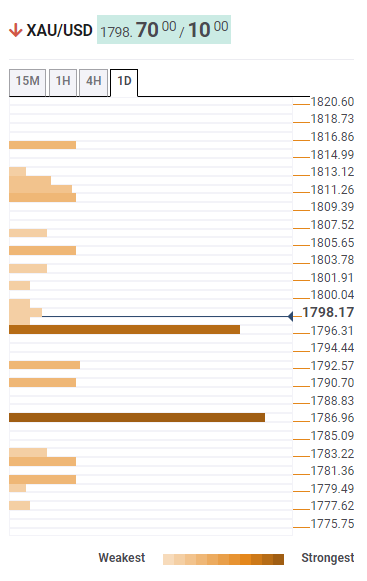
About Technical Confluences Detector
The TCD (Technical Confluences Detector) is a tool to locate and point out those price levels where there is a congestion of indicators, moving averages, Fibonacci levels, Pivot Points, etc. If you are a short-term trader, you will find entry points for counter-trend strategies and hunt a few points at a time. If you are a medium-to-long-term trader, this tool will allow you to know in advance the price levels where a medium-to-long-term trend may stop and rest, where to unwind positions, or where to increase your position size.
- GBP/USD remains sidelined after rising to the highest level in five months.
- Overbought RSI, two-month-old resistance line challenge further upside.
- Bear need validation from the convergence of 200-DMA, previous resistance line from late June.
GBP/USD treads water around mid-1.2200s after rising to the highest level since late June the previous day. In doing so the Cable pair portrays the market’s cautious mood ahead of the key US employment data while also justifying the price-negative technical signals.
Among them, overbought conditions of the Relative Strength Index (RSI) line, placed at 14, gain major attention as the quote struggles after a two-day uptrend that refreshed the multi-day peak.
Also challenging the GBP/USD bulls is the upward-sloping resistance line from early October, currently around 1.2280.
Just in case a wild move cracks the 1.2280 hurdle, the 1.2300 round figure and the mid-June high near 1.2410 could act as additional upside filters to watch during the quote’s further advances.
On the contrary, pullback remains elusive unless the GBP/USD pair remains beyond 1.2150 level comprising the 200-DMA and the resistance-turned-support line from late June.
Additionally, a convergence of the August month’s high and the weekly bottom also constitutes short-term key support near 1.1900 and may test the bears before giving them control.
Following that, tops marked in September and October, respectively near 1.1735 and 1.1645 will be in focus.
GBP/USD: Daily chart
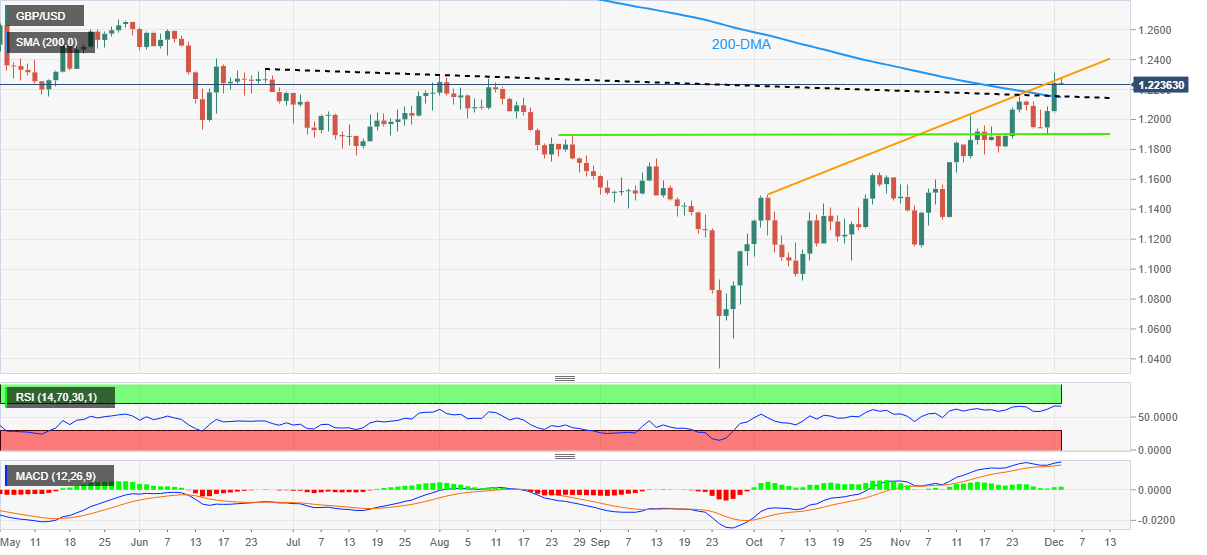
Trend: Limited downside expected
- EUR/USD portrays typical pre-NFP trading lull at five-month high.
- ECB President Christine Lagarde cites economic uncertainty, need for fiscal policy to defend the bloc.
- Downbeat comments from IMF’s Georgieva, anxiety ahead of US NFP also probe bulls.
- Hopes of Fed’s slower rate hike, downbeat expectations from US data favor buyers.
EUR/USD portrays the market’s cautious mood as it steadies near a five-month high surrounding 1.0530 during early Friday.
That said, the major currency pair’s latest inaction could be linked to the mixed concerns surrounding likely downbeat US employment data and economic fears cited by the key policymakers from the US and Europe.
Recently, European Central Bank (ECB) President Christine Lagarde mentioned the need for short-term and bespoke fiscal policy. The policymaker also said, “For sustainable growth, all policies must work together.”
Further, International Monetary Fund (IMF) Managing Director Kristalina Georgieva said that recession risks are rising for many countries, and the outlook for global growth is exceptionally uncertain and dominated by risks. The same challenged the market sentiment and allowed the US Dollar Index (DXY) to take a breather around the lowest levels since early July.
Even so, a record-low Unemployment Rate in the bloc joins dovish comments from the majority of the Fed policymakers, including Chairman Jerome Powell, to keep the EUR/USD buyers hopeful.
Against this backdrop, the S&P 500 Futures drop 0.30% intraday to 4,070 whereas the US 10-year Treasury yields printed a corrective bounce off the 10-week low to 3.54% by the press time.
Moving on, EUR/USD may remain inactive amid a light calendar ahead of the US jobs report and cautious mood. However, the bulls are likely to stay in the driver’s seat as the headline Nonfarm Payrolls (NFP) is expected to ease to 200K print versus 261K prior while the Unemployment Rate could remain unchanged at 3.7%.
Technical analysis
A four-month-old upward-sloping previous resistance line, now support near 1.0500, restricts short-term EUR/USD downside. Meanwhile, the pair’s upside moves could aim for the late June swing high near 1.0615.
- USD/INR bears take a breather around two-week low.
- Sustained trading below 50-DMA, bearish oscillators favor sellers.
- Four-month-old support line, 100-DMA to challenge bears, descending trend line from late October adds to the upside filters.
USD/INR stays defensive around the lowest levels in two weeks, steady around 81.10 by the press time, as bears pause after a four-day south-run during early Friday. Even so, the Indian Rupee (INR) buyers remain hopeful to extend the latest downturn.
That said, the USD/INR pair’s failure to cross the 50-DMA joins the Moving Average Convergence and Divergence (MACD) indicator’s bears signals and downbeat conditions of the Relative Strength Index (RSI) line, placed at 14, to keep bears hopeful.
With this, the intraday sellers could keep attacking the 81.00 threshold ahead of reaching the key support line from early August, near 80.90.
Following that, the 100-DMA level surrounding 80.77 and November’s low of 80.47 could lure the bears afterward.
Alternatively, a convergence of the three-week-old descending trend line and the 50-DMA highlights 81.90 as strong resistance for the USD/INR bulls to crack before retaking control.
Even so, a downward-sloping resistance line from October 20, close to 82.35, could challenge the pair’s further upside.
In a case where AUD/USD remains firmer past 82.35, the odds of its run-up towards the record high marked in October around 83.30 can’t be ruled out.
USD/INR: Daily chart
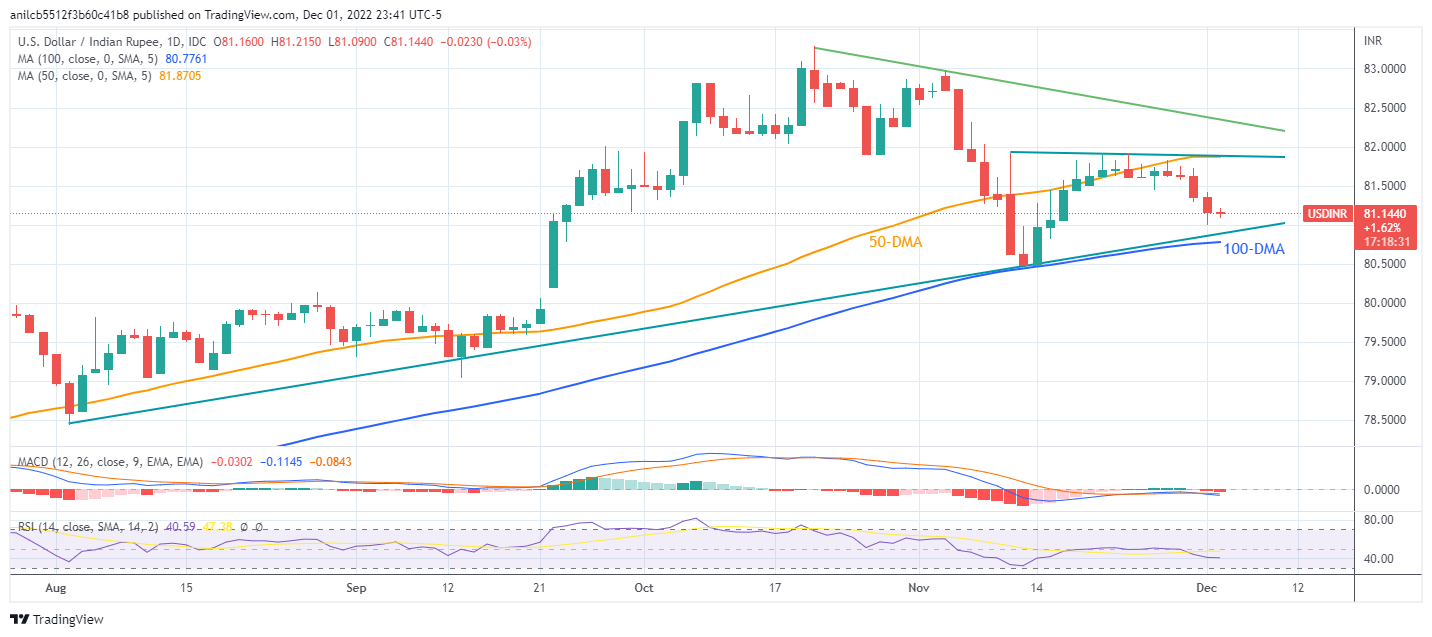
Trend: Further downside expected
- AUD/USD bounces off intraday low to reverse the pullback from 2.5-month high.
- RBA’s Lowe praises domestic spending, conveys monetary policy lags.
- Sluggish markets restrict immediate moves ahead of US employment report for November.
- Dovish bias for the Fed keeps the Aussie bulls hopeful.
AUD/USD struggles to keep the 0.6800 round figure on the table despite the latest rebound from the intraday low as traders remain cautious ahead of the US employment data for November during early Friday.
The Aussie pair’s latest recovery could be linked to comments from Reserve Bank of Australia (RBA) Governor Philip Lowe. The policymaker recently hesitated in conveying the Aussie central bank’s bearish bias while saying that the board discussed the consequences and costs of not raising rates. “Higher interest rates affect the economy with a lag,” mentioned RBA Governor Lowe.
Additionally, hopes of more stimulus from China and a sustained reduction in the Covid numbers also keep the AUD/USD bulls hopeful
On the other hand, downbeat comments from International Monetary Fund (IMF) Managing Director Kristalina Georgieva seemed to have challenged the AUD/USD bulls. IMF’s Georgieva said that recession risks are rising for many countries, and the outlook for global growth is exceptionally uncertain and dominated by risks. On the same line could be the fears surrounding the slowdown in the Initial Public Offering (IPO) markets.
Even so, downbeat US data and bearish comments from the majority of the Fed policymakers, including Chairman Jerome Powell advocated for easy rate hikes, which in turn favor the AUD/USD bulls.
That said, the S&P 500 Futures drop 0.30% intraday to 4,070 whereas the US 10-year Treasury yields printed a corrective bounce off the 10-week low to 3.54% by the press time.
Looking forward, risk catalysts may entertain AUD/USD traders but the pre-NFP mood may restrict immediate moves of the pair. It should be observed, however, that the downbeat projections of the US job numbers suggest further advances by the Aussie pair. Forecasts suggest that the headlines Nonfarm Payrolls (NFP) is likely to ease with a 200K print versus 261K prior while the Unemployment Rate could remain unchanged at 3.7%.
Technical analysis
A clear break of the previous key resistance line from September 13, now support near 0.6765, keeps AUD/USD bulls towards September’s peak of 0.6916.
Reserve Bank of Australia (RBA) Governor Philip Lowe is participating in a panel discussion titled "Growth and Inflation Dynamics" at the Bank of Thailand 80th Anniversary Conference, in Bangkok.
Key quotes
Australia's inflation expectations remain well-anchored.
Domestic spending has been resilient to higher interest rates thus far.
The RBA’s decision to downshift reflects monetary policy lags.
Policy lags are very likely to be longer this cycle.
We are aiming to slow inflation without negatively impacting the economy too much.
Central banks will face much greater variation in inflation.
Must show the public that CPI will return to target.
Market reaction
The Australian Dollar is seeing some fresh demand on RBA Lowe’s comments, as AUD/USD adds 0.04% on the day to trade at 0.6811, at the time of writing.
European Central Bank (ECB) President Christine Lagarde is speaking on growth and inflation at the Bank of Thailand 80th Anniversary Conference, in Bangkok.
Key quotes
Monetary policy is complicated by three uncertainties.
Including the global economy and CPI developments.
Central banks must work to make sure CPI falls back to target.
We are hoping for short-term and bespoke fiscal policy.
For sustainable growth, all policies must work together.
Increased investment and structural reforms are required to remove supply constraints.
Market reaction
The Euro paid little to no heed to the comments from ECB President Lagarde. EUR/USD is, therefore, keeping its range around 1.0515, down 0.09% on the day, as of writing.
People's Bank of China (PBOC) Yi Gang said in a statement on Friday, “I predict moderate inflation in 2023.”
Additional quotes
Right now, our focus is on growth.
Monetary policy has been quite accommodating.
Market reaction
AUD/USD is trading almost unchanged on the day just above 0.6800, awaiting the US Nonfarm Payrolls data for a fresh direction.
- Silver price remains on pressured around intraday low after reversing from multi-day high.
- Overbought RSI triggered pullback but bears need validation from three-week-old horizontal support.
- XAG/USD bulls will wait for clear break of two-month-old resistance line for re-entry.
Silver price (XAG/USD) snaps a three-day uptrend as it retreats from the highest levels since early May, marked the previous day, to $22.60 on Friday.
Although the cautious mood ahead of the US employment report for November could be held responsible for the metal’s pullback, overbought RSI also teased intraday bears of the commodity. Furthermore, the failures to provide a sustained break of an upward-sloping resistance line from October add strength to the corrective moves.
However, a horizontal area comprising multiple levels marked since November 11, around the $22.00 threshold, restricts the short-term downside of the Silver price.
Following that, a monthly support line near $21.25 appears the last defense of the XAG/USD buyers.
In a case where the Silver price remains bearish past $21.25, the $21.00 and the late November lows near $20.60 should quickly return to the chart.
Meanwhile, sustained trading beyond the two-month-old ascending resistance line, close to $22.75 by the press time, appears necessary to convince the Silver buyers.
Even so, the $23.00 round figure and May’s high near $23.30 could act as extra filters to the north before giving control to the XAG/USD bulls.
Silver price: Four-hour chart
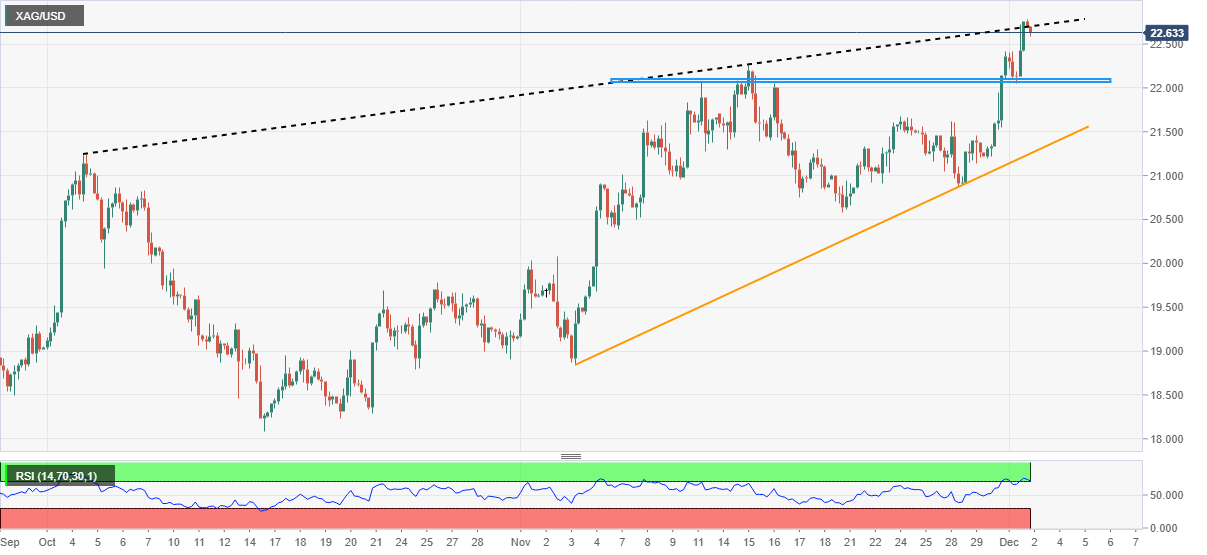
Trend: Limited downside expected
- USD/CHF snaps two-day downtrend as buyers prepare for US jobs report.
- Cautious mood, rebound in yields allow bears to take a breather amid sluggish session.
- US NFP could recall pair bears on downbeat forecasts, dovish Fed outlook.
USD/CHF picks up bids to pare recent losses around the lowest levels in a fortnight during early Friday. That said, the Swiss Franc (CHF) pair rebounds to 0.9385 by the press time.
The quote’s latest consolidation could be linked to the anxiety ahead of the key US employment data, as well as recent comments from International Monetary Fund (IMF) Managing Director Kristalina Georgieva.
The cautious mood before the US Nonfarm Payrolls (NFP) gained extra strength after New York Fed’s John Williams stated that the Fed has a ways to go with rate rises.
On the other hand, IMF’s Georgieva said that recession risks are rising for many countries, the outlook for global growth is exceptionally uncertain and dominated by risks.
Also likely to have probed the USD/CHF bears could be the fears surrounding the slowdown in the Initial Public Offering (IPO) markets.
While portraying the mood, the S&P 500 Futures drop 0.30% intraday to 4,070 whereas the US 10-year Treasury yields printed a corrective bounce off the 10-week low to 3.54% by the press time.
However, the USD/CHF bears remain hopeful as the majority of the Fed policymakers, including Chairman Jerome Powell advocated for easy rate hikes. On the same line were the comments from US Treasury Secretary Janet Yellen. Furthermore, mostly downbeat United States data also weigh on USD/CHF prices.
It should be noted that the softer economics from Switzerland also challenged the USD/CHF bears of late. Swiss Real Retail Sales dropped by 2.5% YoY in October versus anticipated growth of 3.3% and 2.5% (revised) prior. Additionally, the nation’s Consumer Price Index (CPI) matched 3.0% YoY forecasts and prior while missing on MoM to 0.0% versus 0.1% expected and previous readings.
To sum up, USD/CHF portrays the pre-data correction and is likely to decline further after the US statistics. Forecasts suggest that the headlines Nonfarm Payrolls (NFP) is likely to ease with a 200K print versus 261K prior while the Unemployment Rate could remain unchanged at 3.7%.
Technical analysis
Despite the latest rebound, the USD/CHF bears remain hopeful of breaking the previous monthly low of 0.9355 unless the quote stays firmer beyond the support-turned-resistance line from November 15, close to 0.9415 by the press time.
Masayoshi Amamiya, Deputy Governor at the Bank of Japan (BoJ), said on Friday, “Japan’s inflation is 'very high' now but is likely to slow back below 2% next year.”
Additional comments
Even if BoJ incurs short-term loss on its asset holdings, that won't affect its ability to guide monetary policy appropriately.
If yields rise by 1% for Japan's entire yield curve, that will lead to an evaluation loss of 28.6 trln yen in BoJ’s bond holdings.
Uncertainty over Japan's economic outlook is extremely high.
Market reaction
USD/JPY is holding steady at around 135.25, unfazed by the BoJ-speak, at the press time.
- EUR/USD bulls could be about to throw in the towel.
- The bears eye a break of the consolidation below 1.0220.
EUR/USD is stalling on the bid which gives rise to the prospects of the capitulation of the bulls in speculating that the 1.0500s could be the last stop in this bull cycle from a technical perspective across the charts. The following is an analysis across multiple time frames from a bearish perspective:
EUR/USD H1 chart
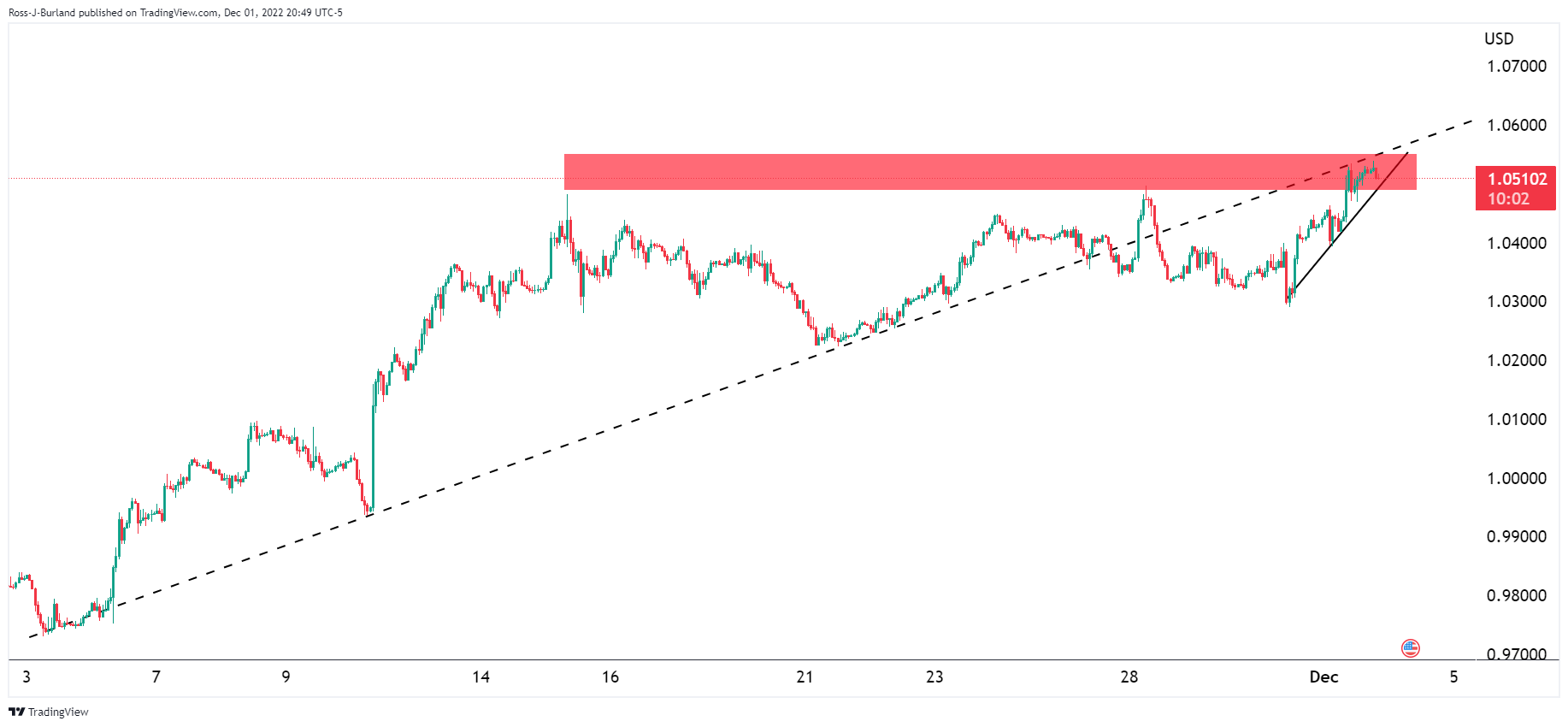
The price is holding the supporting trendline but it could be climaxing in a steep rally.
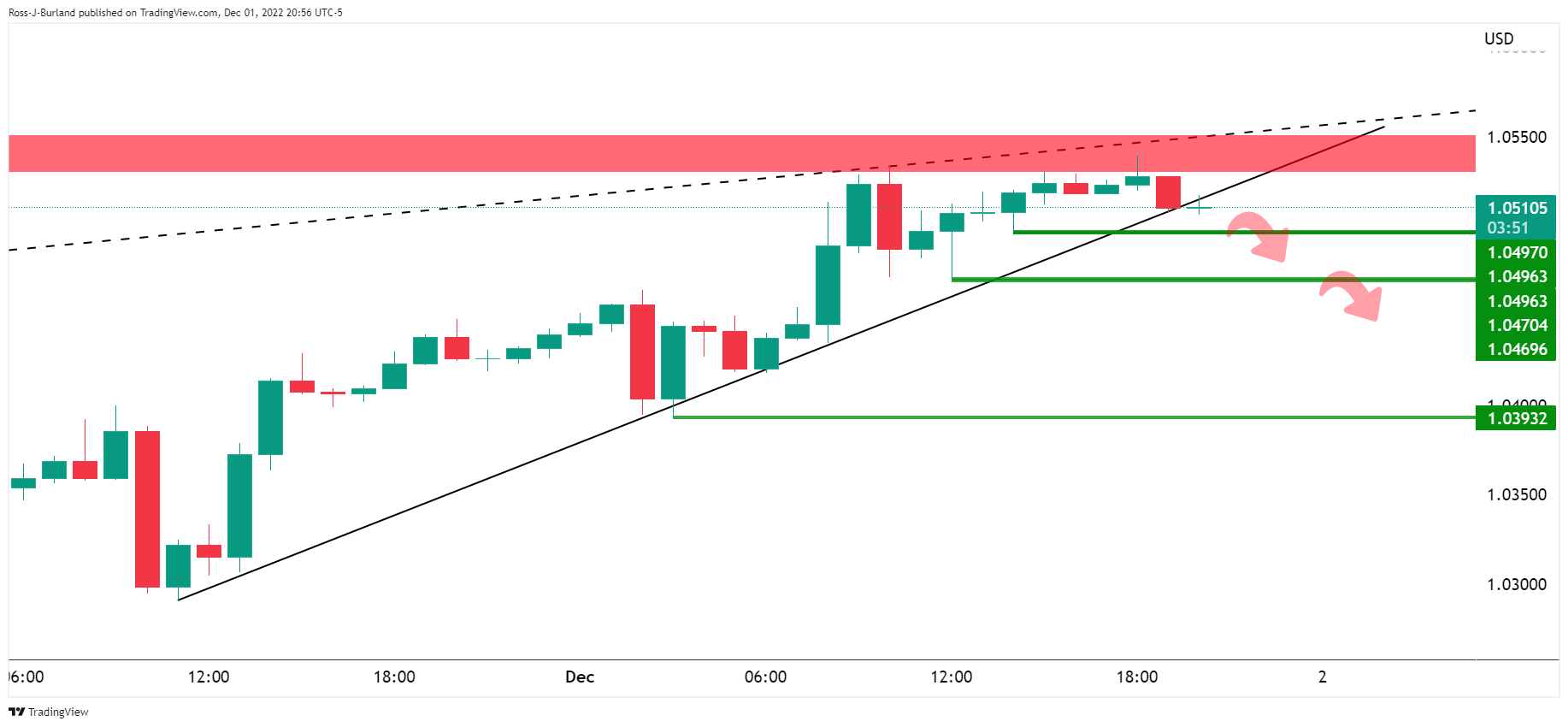
This could give rise to a break of structures in the sessions ahead.
EUR/USD H4 chart
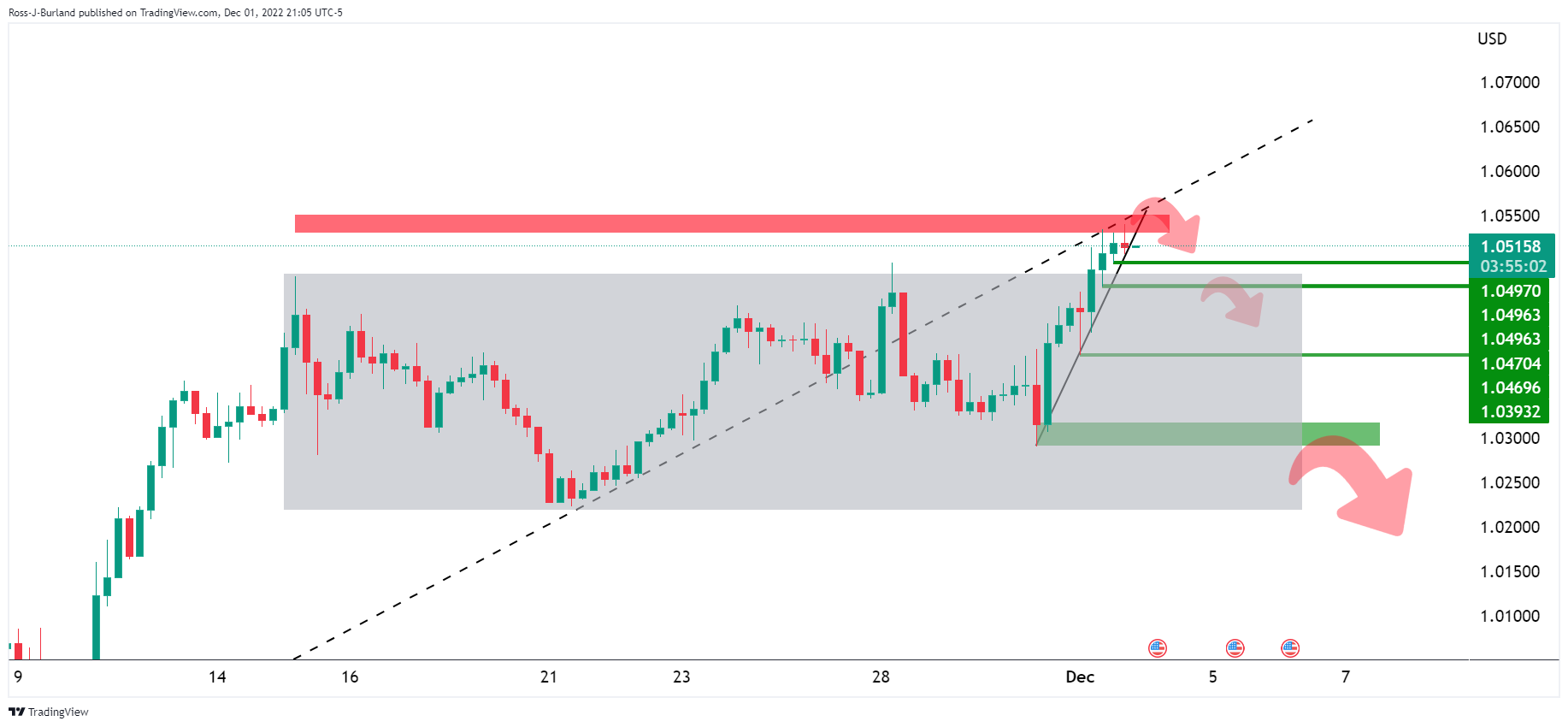
The move through the highs of the sideways consolidation could be a sweep of liquidity. If this is the case, the focus will be on the downside for next week:
EUR/USD daily chart
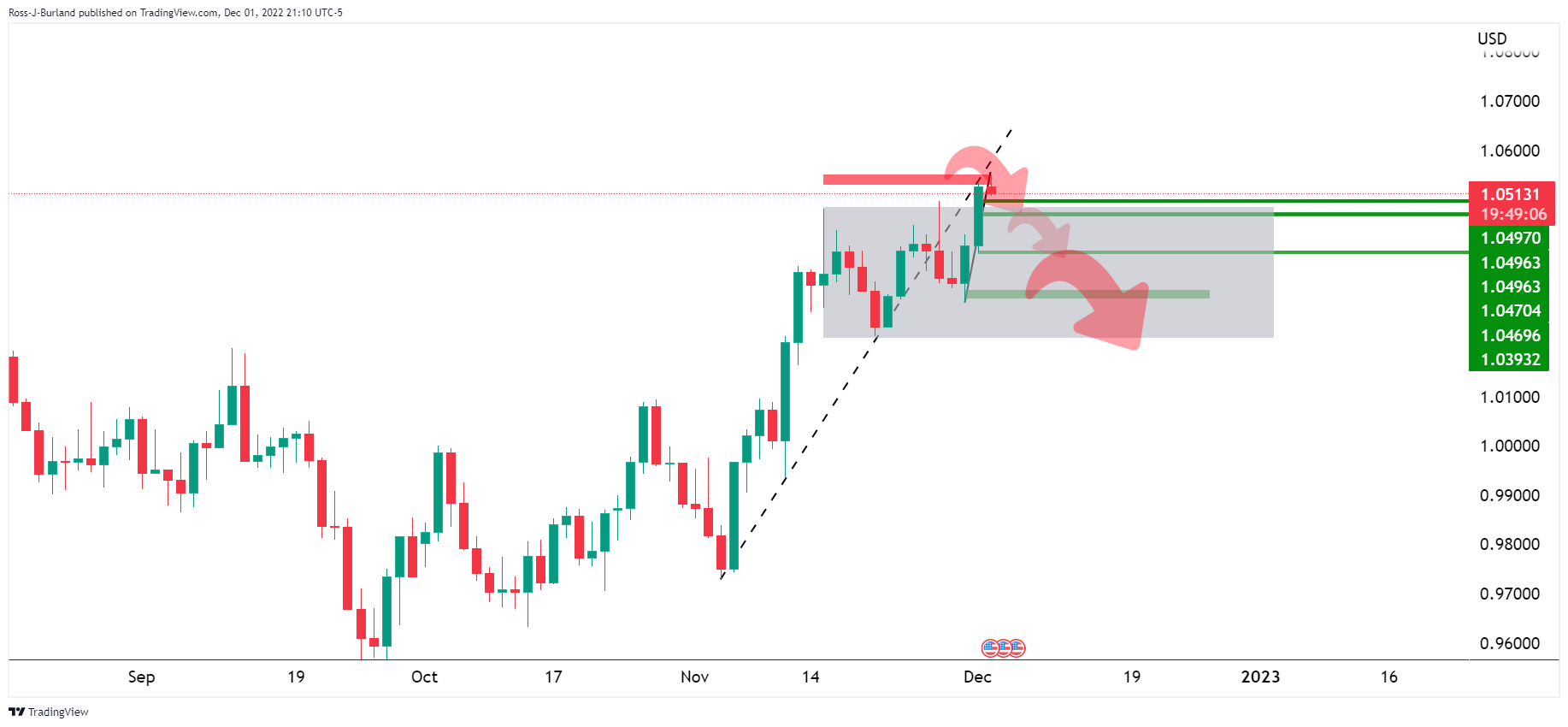
The bears eye a break of the consolidation below 1.0220.
However, a move beyond 1.0550 will leave the bulls in the runnings for higher highs for the end of the year as per the weekly breakout of trend:

| Raw materials | Closed | Change, % |
|---|---|---|
| Silver | 22.747 | 2.23 |
| Gold | 1803.06 | 1.86 |
| Palladium | 1939.54 | 3.1 |
- NZD/USD retreats from a four-month high, snaps three-day uptrend after refreshing multi-day top.
- 61.8% Fibonacci retracement level probes buyers amid overbought RSI.
- Convergence of 200-DMA, monthly support line restricts immediate downside.
NZD/USD pares recent gains at the highest levels since early August as it prints mild losses around 0.6365 during early Friday.
In doing so, the Kiwi pair retreats from the 61.8% Fibonacci retracement level of the pair’s April-October moves, near 0.6460, amid the overbought RSI (14).
That said, the 50% Fibonacci retracement level near 0.6275 lures intraday sellers before highlighting the 0.6230 support confluence, encompassing the 200-DMA and a one-month-old ascending trend line.
Should the quote remains bearish past 0.6230, the odds of witnessing a south-run towards the previous resistance line from early April, near 0.6090, can’t be ruled out.
Alternatively, a daily closing beyond the 61.8% Fibonacci retracement level surrounding 0.6460, also known as the golden ratio, becomes necessary for the NZD/USD buyer’s return.
Following that, a horizontal area around 0.6570 including the tops marked in May and June will be crucial to watch as a break which could give a free hand to the bulls targeting March’s low near 0.6730.
Overall, NZD/USD is likely to decline further but the downside appears limited.
NZD/USD: Daily chart
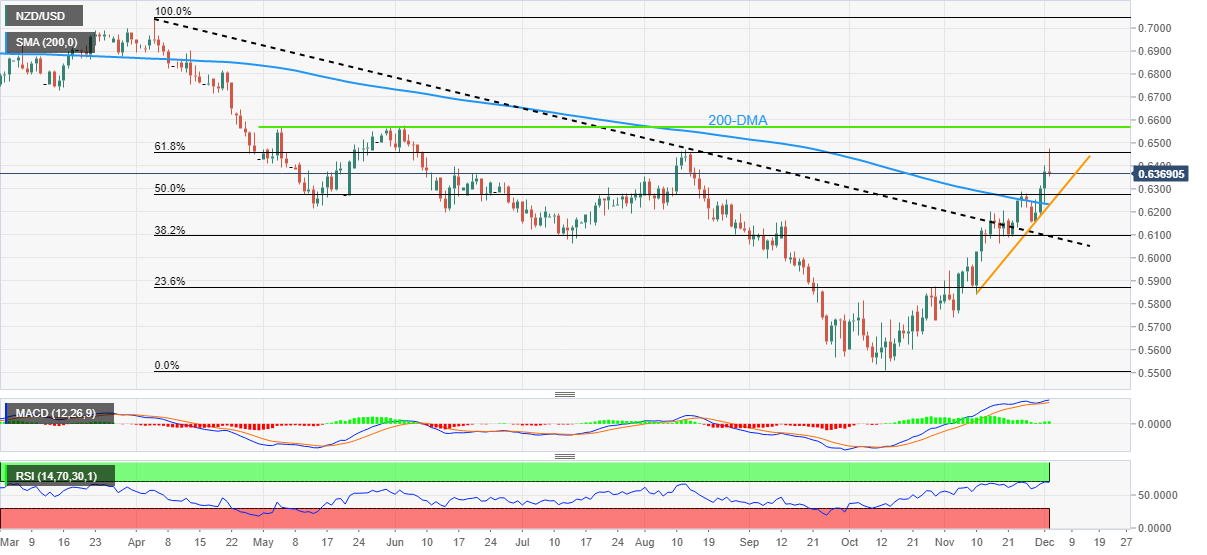
Trend: Limited downside expected
Chinese Finance Minister Liu Kun is out with some conciliatory comments this Friday morning.
Key quotes
Will continue with policy stimulus and generally stable yuan.
Will continue to implement policy package, strive to realize the goal of creating 11 million new urban jobs.
Will keep economy within a reasonable range and strive to realise better results.
China’s economy will keep growing at reasonable speed, with stable employment and prices.
Will continue to deepen reform and opening up, keep yuan exchange rate generally stable at appropriate and balanced level.
Market reaction
AUD/USD is keeping mild losses at around 0.6800, unimpressed by the above comments. The pair is down 0.09% on the day.
- Gold price retreats from four-month high, snaps three-day uptrend.
- Market’s consolidation ahead of the key US jobs reports probes XAU/USD bulls.
- IMF’s Georgieva cites recession risks to strengthen gold’s pullback moves.
- US NFP may renew the metal’s upside but $1,807 is the key hurdle to watch.
Gold price (XAU/USD) repeats the typical pre-NFP consolidation as it slides from a four-month high to $1,798 during early Friday. In doing so, the yellow metal prints the first daily loss in four amid cautious markets.
In addition to the anxiety ahead of the key US employment data, recent comments from International Monetary Fund (IMF) Managing Director Kristalina Georgieva also seemed to have probed the XAU/USD bulls amid sluggish trading hours. “Recession risks are rising for many countries, the outlook for global growth is exceptionally uncertain and dominated by risks,” said IMF’s Georgieva.
Additionally, fears surrounding the slowdown in the Initial Public Offering (IPO) markets could also be cited as a distant catalyst for the Gold price pullback. “A global slowdown in initial public offerings due to heightened market volatility and a regulatory cloud over new listings from China has created pent-up demand that could lead to an IPO boom in 2023, industry executives told the Reuters NEXT conference.”
Furthermore, the recent comments from New York Fed’s John Williams seemed to have tested the US Dollar bears, as well as favored Gold sellers, as the policymakers stated that the Fed has a ways to go with rate rises.
Amid these plays, the S&P 500 Futures drop 0.30% intraday to 4,070 whereas the US 10-year Treasury yields printed a corrective bounce off the 10-week low to 3.53% by the press time.
It’s worth noting, however, that the dovish concerns surrounding the US Federal Reserve’s (Fed) next move, backed by the downbeat Fedspeak and softer US data, seem to keep the gold bears hopeful ahead of the US employment. Forecasts suggest headline Nonfarm Payrolls (NFP) is likely to ease with a 200K print versus 261K prior while the Unemployment Rate could remain unchanged at 3.7%. It should be noted that a likely easing in the Average Hourly Earnings for the stated month could also weigh on the Gold price.
Technical analysis
Overbought conditions of the Relative Strength Index (RSI) line, placed at 14, triggered the Gold price retreat from a multi-day top. The pullback moves, however, remain elusive as the Moving Average Convergence and Divergence (MACD) indicator flashes bullish signals.
That said, the previous monthly top surrounding $1,787 restricts the immediate downside of the yellow metal ahead of highlighting the $1,757-55 support confluence including the 100-SMA and the resistance-turned-support line from November 15.
Following that, two-month-old horizontal support near $1,730 could act as the last defense of the Gold buyers.
Alternatively, an upward-sloping resistance line from early October joins the tops marked in August to highlight the $1,807 as the key hurdle to the north.
Gold price: Four-hour chart
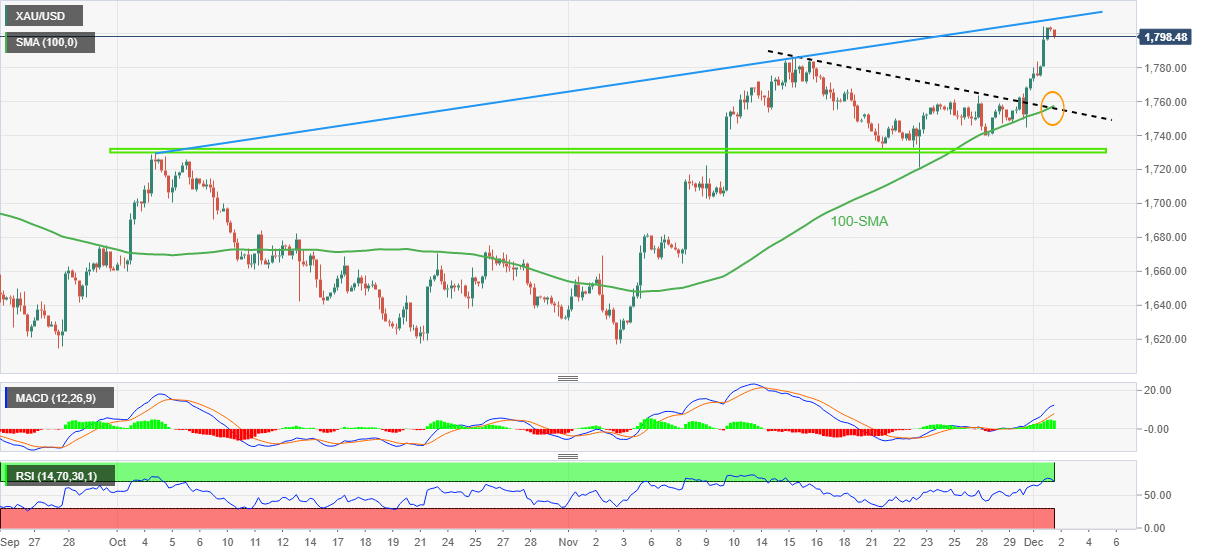
Trend: Limited downside expected
Bank of Japan Governor Haruhiko Kuroda is holding a press conference about monetary policies in Tokyo.
Key quotes
Global economic slowdown has been observed, and Japan's inflation is expected to decelerate from 2023.
More to come...
USD/JPY update
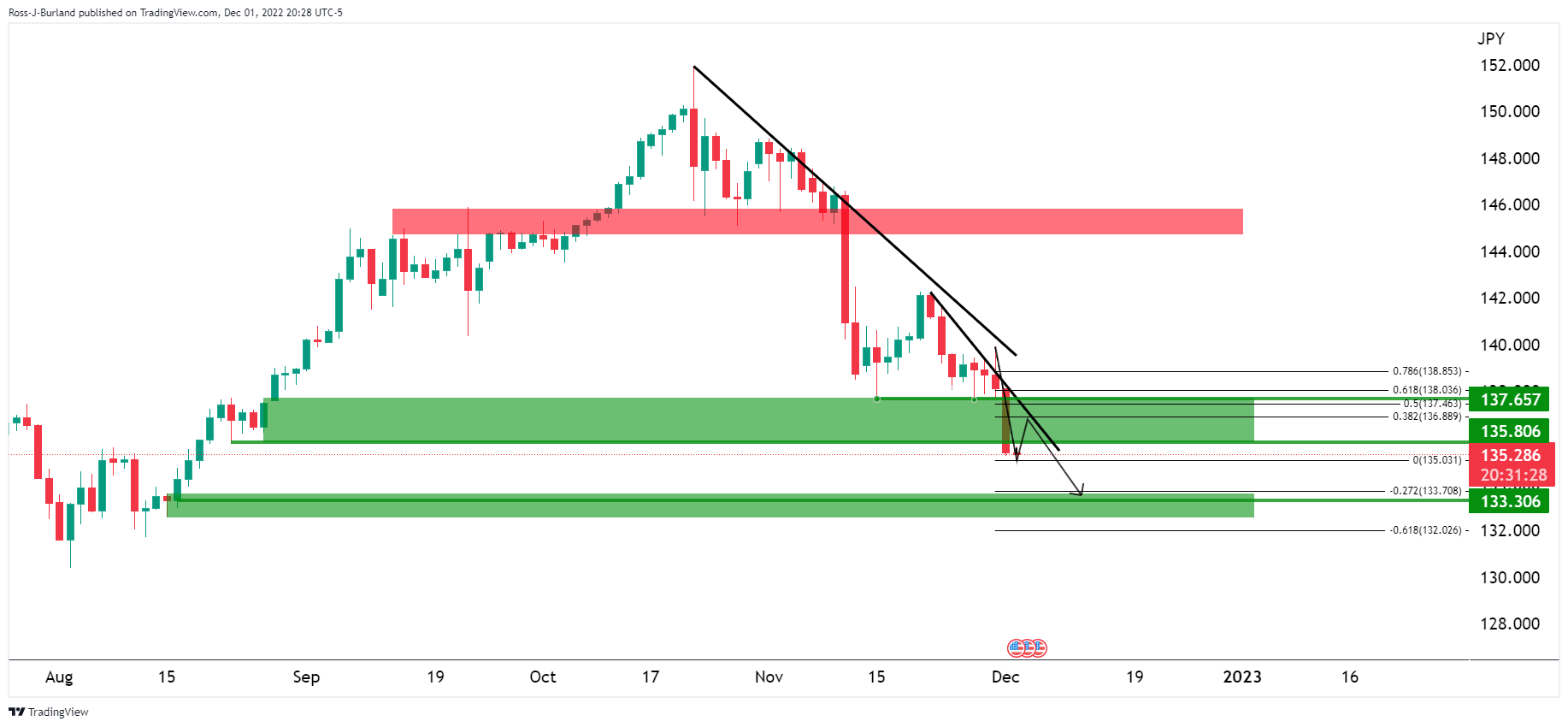
The price remains on the front side of the downtrend and that leaves the outlook bearish for the near future on an intraday basis. However, there are prospects of a bullish correction in the lower time-frames so long as 135.00 can hold up:
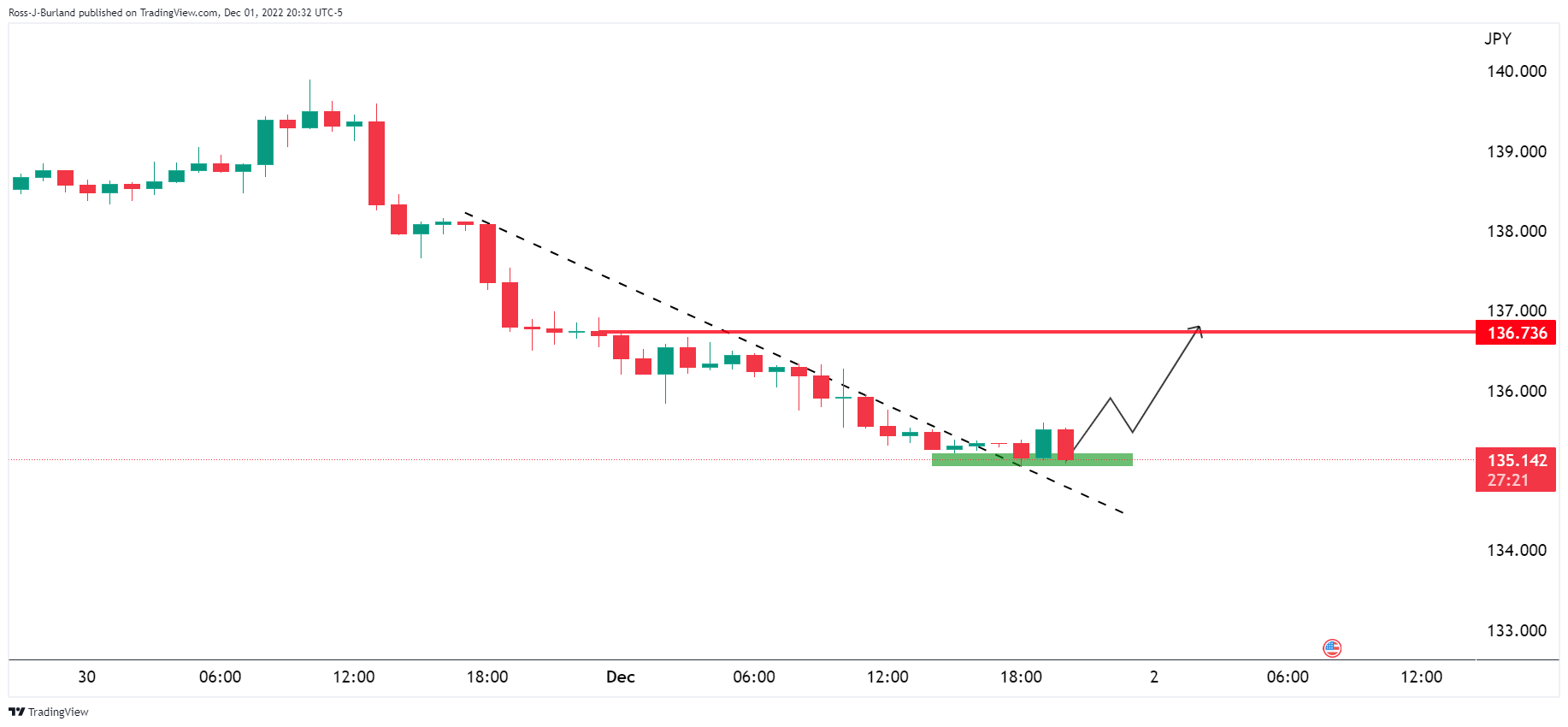
About BoJ governor Kuroda
Mr Kuroda exercises general control over the Bank's business. He is in charge of the Internal Auditors' Office.
- GBP/USD fades upside momentum as multi-day high as markets prepare for the key US employment data.
- Rebound in US Treasury bond yields joins mildly offered stock futures to underpin the pullback in the Cable prices.
- Downbeat UK PMIs, house prices test GBP/USD bulls amid consolidation wave.
- Bulls stay hopeful as dovish bias from Fed could strengthen on softer US jobs report.
GBP/USD takes a U-turn from the highest levels since late June, marked the previous day, as markets consolidate ahead of the key US employment report for November during early Friday. That said, the Cable pair refreshes intraday low near 1.2230 by the press time.
In addition to the pre-NFP anxiety, the quote’s latest weakness could also be linked to the market’s mildly downbeat sentiment and softer data from the UK.
While portraying the mood, the S&P 500 Futures drop 0.30% intraday to 4,070 whereas the US 10-year Treasury yields printed a corrective bounce off the 10-week low to 3.53% by the press time.
The reason could be linked to fears surrounding the slowdown in the Initial Public Offering (IPO) markets. “A global slowdown in initial public offerings due to heightened market volatility and a regulatory cloud over new listings from China has created pent-up demand that could lead to an IPO boom in 2023, industry executives told the Reuters NEXT conference.”
Elsewhere, The Business Times from Singapore mentioned that the UK’s house prices registered the fastest drop since June 2020 in November, down 1.4% versus the 0.4% expected. On the contrary, record-high fresh food inflation and improvement in the UK’s final readings of S&P Global/CIPS Manufacturing PMI for November seem to challenge the GBP/USD bears.
On the same line are the hawkish hopes from the Bank of England (BOE), as well as the recently dovish calls surrounding the Federal Reserve’s (Fed) next move. Additionally, downbeat US numbers surrounding inflation and activity also weigh on the US Dollar and keep the GBP/USD bulls hopeful.
Moving on, the US jobs report for November will be crucial for the GBP/USD buyers amid calls of witnessing downbeat data and fears of more declines by the Greenback. That said, the headline Nonfarm Payrolls (NFP) is likely to ease with a 200K print versus 261K prior while the Unemployment Rate could remain unchanged at 3.7%. It should be noted that a likely easing in the Average Hourly Earnings for the stated month could also weigh on the DXY.
Also: Nonfarm Payrolls Preview: Dollar selling opportunity? Low expectations to trigger temporary bounce
Technical analysis
Failure to provide a daily closing beyond a two-month-old ascending resistance line, around 1.2270 by the press time, joins overbought RSI (14) to tease sellers. However, the bullish bias remains intact until the quote breaks the 200-DMA support of 1.2150.
In recent trade today, the People’s Bank of China (PBOC) set the yuan (CNY) at 7.0542 vs. the last close of 7.0550.
About the fix
China maintains strict control of the yuan’s rate on the mainland.
The onshore yuan (CNY) differs from the offshore one (CNH) in trading restrictions, this last one is not as tightly controlled.
Each morning, the People’s Bank of China (PBOC) sets a so-called daily midpoint fix, based on the yuan’s previous day's closing level and quotations taken from the inter-bank dealer.
- USD/JPY remains sidelined after declining to the lowest levels since mid-August.
- Cautious mood ahead of the key US data, speech from BOJ’s Kuroda probe bears after heavy downside.
- Chatters surrounding BOJ’s tweak propel the Yen, higher odds favoring Fed’s 50 bps rate hike weigh on US Dollar.
- BOJ’s Kuroda must defend easy money policy to push back bears as US NFP is likely to disappoint.
USD/JPY consolidates recent losses at the lowest levels in nearly four months as bounces off 135.03 to 135.50 as Tokyo opens on Friday.
The Yen pair’s latest rebound could be linked to the cautious mood ahead of a speech from Bank of Japan (BOJ) Governor Haruhiko Kuroda and the key US employment data for November.
Even so, the USD/JPY pair remains pressured amid chatters surrounding the Bank of Japan’s policy change.
Recently, Japan Finance Minister Shunichi Suzuki says he will continue to carefully monitor moves in FX. Before him, Japanese media Asahi quotes Bank of Japan Board Member, Naoki Tamura, as saying, “The Bank of Japan should conduct a review of its monetary policy framework and the feasibility of its 2% inflation target.”
It’s worth noting that BOJ board member Asahi Noguchi recently signaled the Japanese central bank’s readiness to withdraw stimulus if inflation numbers appear too strong, which in turn drowned the USD/JPY prices.
Contrary to the hawkish concerns surrounding the BOJ, hopes of slower rate hikes from the US Federal Reserve (Fed) exert downside pressure on the USD/JPY prices.
The dovish bias of the Federal Reserve (Fed) Chairman Jerome Powell, as well as downbeat comments from US Treasury Secretary Janet Yellen, previously raised hopes of an easy rate hike from the US central bank. Following that, Federal Reserve (Fed) Governor Michelle Bowman stated that (It is) appropriate for us to slow the pace of increases. Before him, Fed Governor Jerome Powell also teased the slowing of a rate hike while US Treasury Secretary Yellen also advocated for a soft landing. Further, Vice Chair of supervision, Michael Barr, also said, “We may shift to a slower pace of rate increases at the next meeting.” It’s worth noting that the recent comments from New York Fed’s John Williams seemed to have tested the US Dollar bears as the policymakers stated that the Fed has a ways to go with rate rises.
Other than the central bank concerns, improvement in China’s Covid conditions and downbeat US data also weigh on the USD/JPY prices.
That said, the benchmark US 10-year Treasury bond yields slumped to 3.50% while the two-year counterpart printed 4.23% while poking the lowest levels since October, around 3.53% and 4.26% by the press time. However, Wall Street closed mixed but the S&P 500 Futures remain mildly offered at the latest.
Moving on, BOJ’s Kuroda will be crucial for the USD/JPY pair’s immediate moves amid hawkish concerns and may weigh on the prices. However, the Governor is famous for his dovish comments and hence can defend the latest corrective bounce ahead of a likely negative move due to the expectedly softer US employment data.
Also: Nonfarm Payrolls Preview: Dollar selling opportunity? Low expectations to trigger temporary bounce
Technical analysis
USD/JPY rebound appears elusive unless the quote stays beyond the previous support line from late May, near 137.70 by the press time. That said, the 200-DMA restricts the pair’s immediate downside to around 134.50.
The Reserve Bank of Australia will go for another modest 25 basis-point interest rate hike on December 6 to 3.10%, its third in a row after a succession of half-point moves, according to all 30 economists polled by Reuters.
Additional findings
The RBA is forecast to raise rates by another 50 basis points by the end of the second quarter next year, according to the median forecast, taking the terminal rate to 3.60%. Those expectations were unchanged from a November poll.
However, there was no clear majority among economists over the central bank's rate move beyond the December meeting.
While 12 of 30 economists expected the cash rate to go up by 50 basis points in Q1 2023, 11 said 25 basis points, one said 40 basis points and six expected no change.
For the following quarter, 15 of 29 see rates at 3.60% or higher, the other 14 said lower with some seeing the peak as low as 3.10%.
Also read: AUD/USD Price Analysis: Retreats from 200-day EMA with eyes on 0.6770
Japan finance minister Shun'ichi Suzuki says he will continue to carefully monitor moves in FX. The comment comes at a time, however, whereby the US Dollar is falling and the Yen rising sharply:
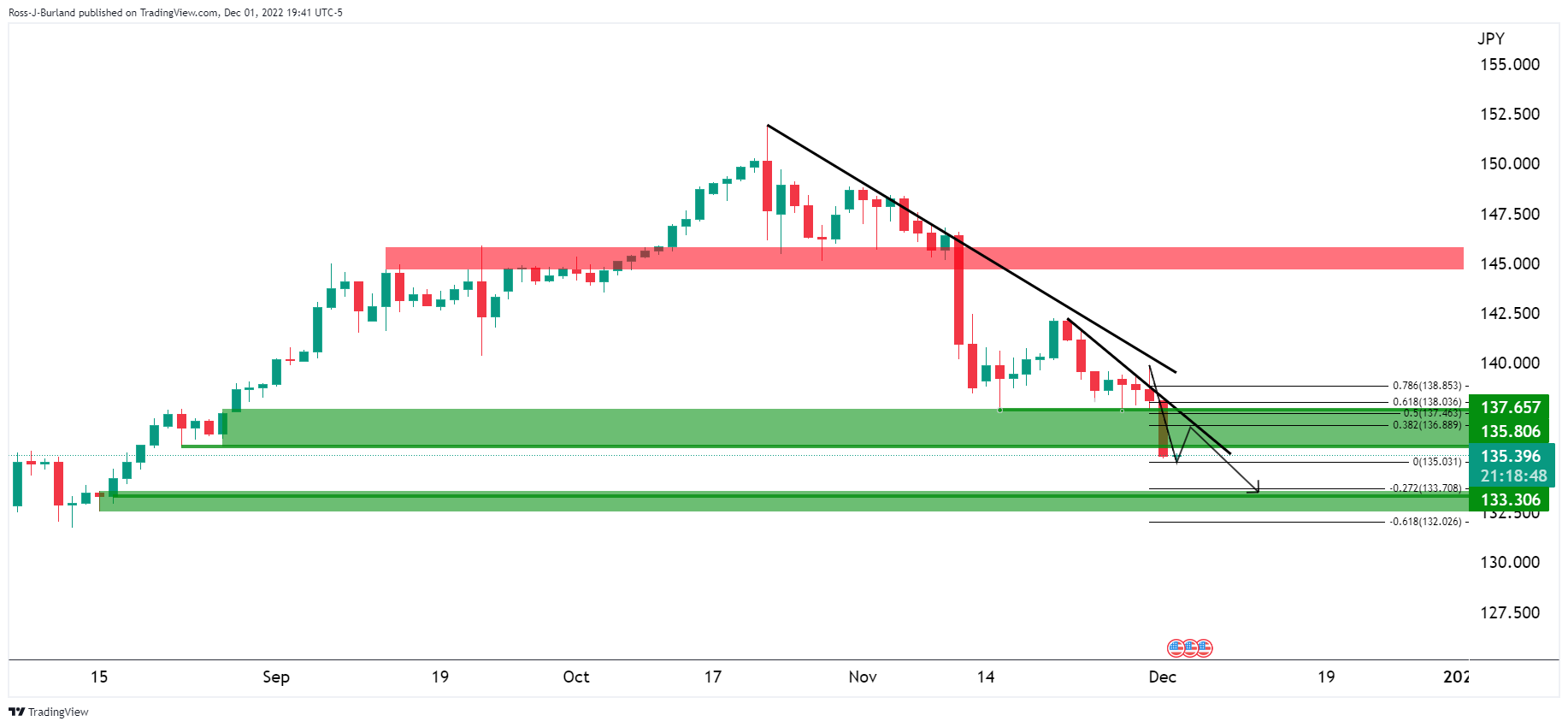
| Index | Change, points | Closed | Change, % |
|---|---|---|---|
| NIKKEI 225 | 257.09 | 28226.08 | 0.92 |
| Hang Seng | 139.21 | 18736.44 | 0.75 |
| KOSPI | 7.31 | 2479.84 | 0.3 |
| ASX 200 | 70.2 | 7354.4 | 0.96 |
| FTSE 100 | -14.61 | 7558.49 | -0.19 |
| DAX | 93.26 | 14490.3 | 0.65 |
| CAC 40 | 15.42 | 6753.97 | 0.23 |
| Dow Jones | -194.76 | 34395.01 | -0.56 |
| S&P 500 | -3.54 | 4076.57 | -0.09 |
| NASDAQ Composite | 14.45 | 11482.45 | 0.13 |
- West Texas Intermediate (WTI) bulls are pressured despite China easing Coronavirus restrictions.
- Organization of the Petroleum Exporting Countries (OPEC) meeting in high anticipation.
- US Dollar heavy on dovish Federal Reserve chair Jerome Powell.
West Texas Intermediate (WTI) was buoyed by easing COVID-19 restrictions in China. However, at the time of writing, WTI is lower by some 0.2% in early Asia and hovers around $81.20 although remains in bullish territory having rallied through a major downside channel this week. WTI was reaching a high of $83.32bbls, taking out liquidity above the mid-November structure between $81.90bbls and $82.50bbls.
Organization of the Petroleum Exporting Countries meeting in high anticipation
The potential reopening of China presents a challenge for the Organization of the Petroleum Exporting Countries (OPEC) and Sunday's virtual meeting of members is in high anticipation as there is no clear indication of whether the cartel will keep current quotas in place or cut production to support prices. Cuts to OPEC supply have already helped to stabilise the market.
China relaxes coronavirus measures
Meanwhile, raising expectations of higher demand for oil. it was reported that Sun Chunlan, China's vice-premier, announced that the nation may be ready to amend its Zero-Covid policy. Shanghai, Guangzhou and a few other cities are lifting some quarantines despite rising case numbers. Guangzhou has been reported that it has lifted all restrictions in several districts.
Analysts at TD Securities explained that oil demand had suffered under the strict measures to contain the virus, with implied oil demand currently at 13 million barrels per day (mb/d) 1mb/d lower than average. ''China’s National Petroleum Corp estimates the demand is likely to fall 2% in 2022. The fall in consumption of Oil products has been even greater, down 7.3%. However, it expects demand to rise 2.1% next year as restrictions ease,'' the analysts at TDS said.
US Dollar falls further on dovish Federal Reserve
Away from direct oil industry fundamentals, WTI was made cheaper to the WTI market on the back of a drop in the US Dollar leading to speculative bids in Oil. On Wednesday, Federal Reserve chair Jerome Powell said in a speech that the Fed may moderate future rate hikes, with smaller rate hikes coming as soon as the Federal Open Market Committee (FOMC) meeting of its policy committee later this month.
“The time for moderating the pace of rate increases may come as soon as the December meeting,” Powell said in remarks at the Brookings Institution. Consequently, it was risk-on, with the US Dollar dropping, US Treasury yields eased and stocks rose. The S&P 500 ended its three-day losing streak and closed up 2.7% while the Dow officially entered a bull market.
Lastly, declining US Oil stocks were seen with the Energy Information Administration on Wednesday reporting that crude Oil inventories fell by 12.9 million barrels last week. This was supportive of WTI and was the biggest drop since June 2019. However, gasoline and distillate inventories were rising.
WTI technical levels

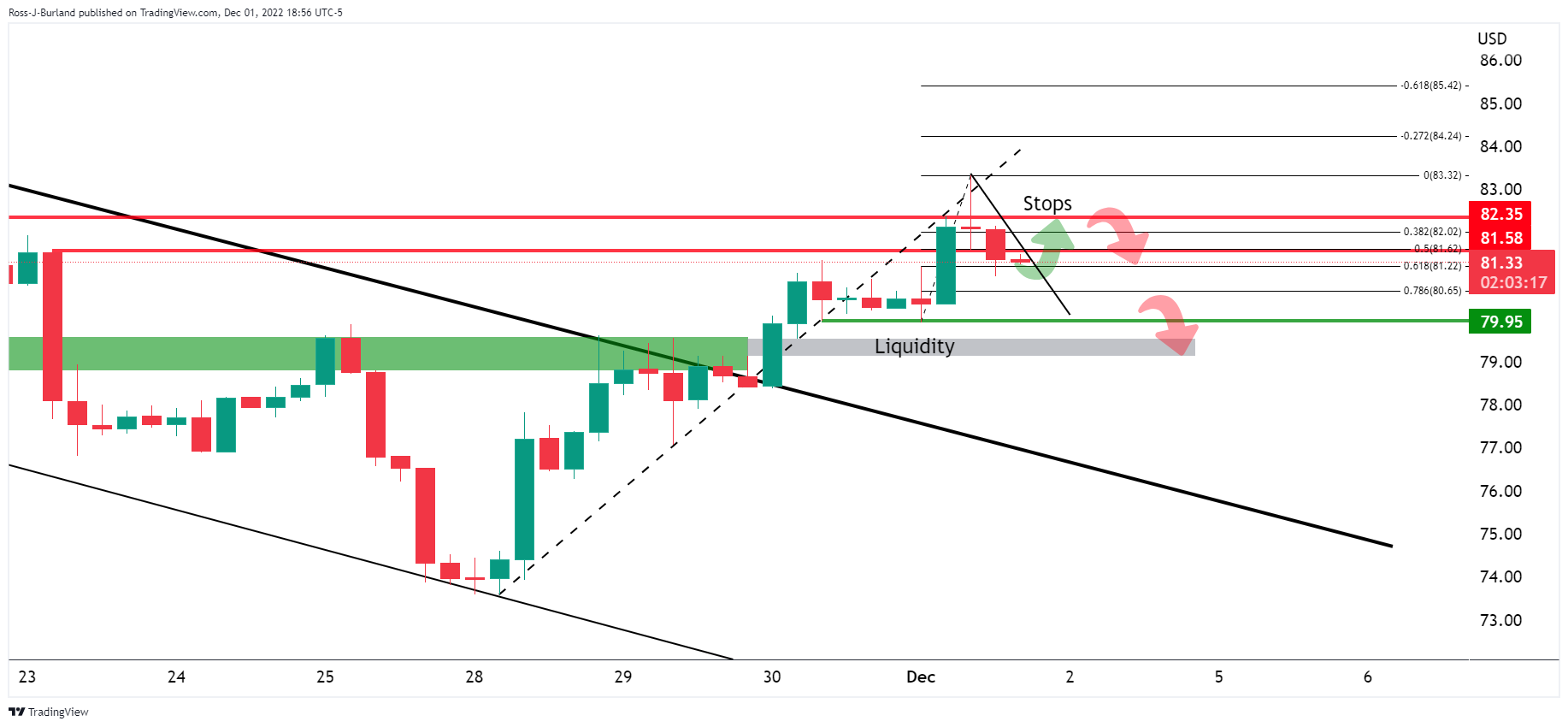
In the above daily charts, WTI is seen moving into prior highs and this has swept liquidity. The Oil price is now being faded. It is common for the highs to be retested in such a schematic and on the 4-hour chart we can Oil sliding out of the trendline resistance as follows:

A move towards where WTI short position stops are likely located could be the next port of call if there is not to be an immediate continuation of the downside in Oil to target liquidity below $78.00.
However, while below $81.50, the bias is in WTI is on the downside:
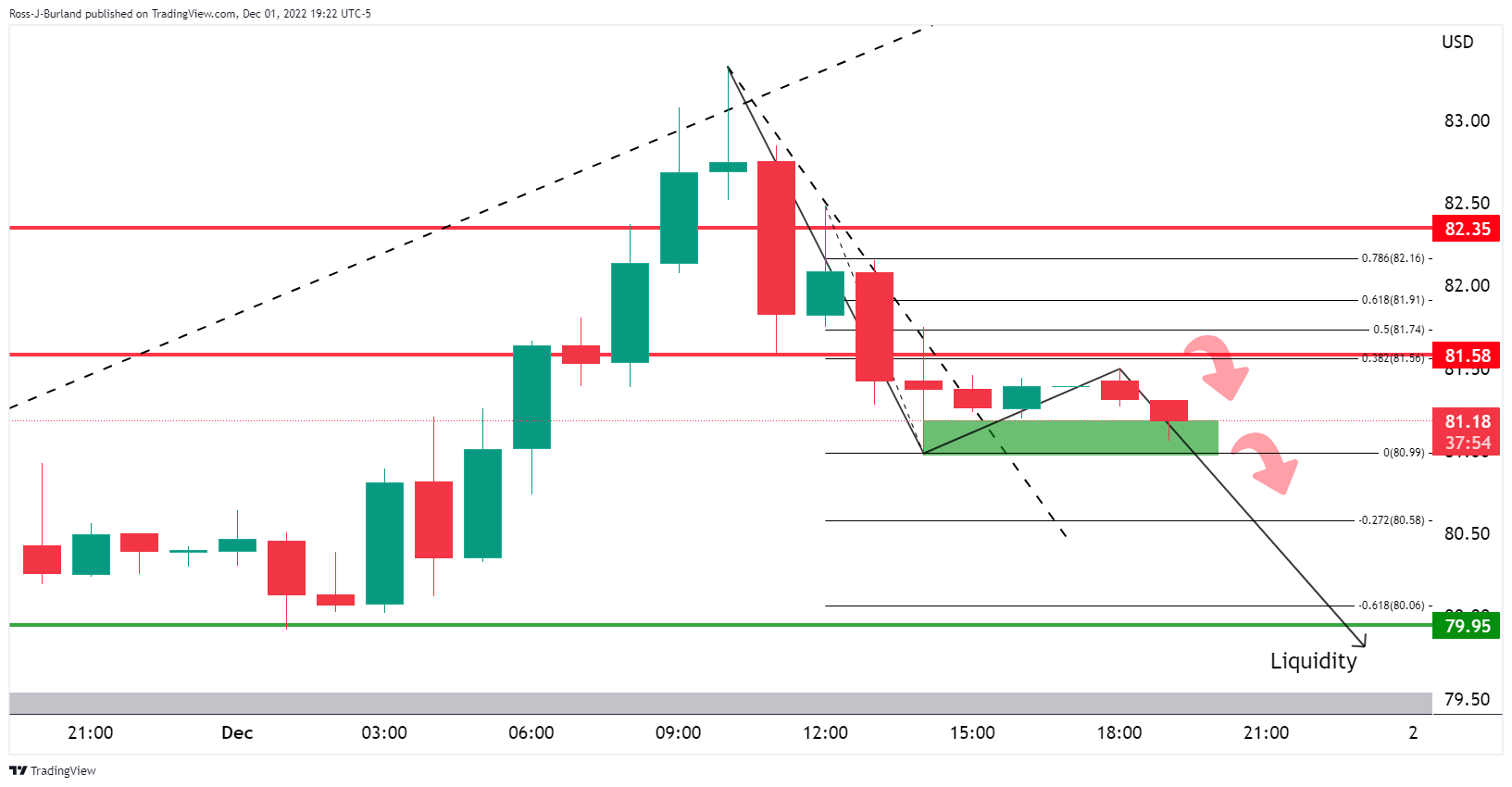
- AUD/USD pares recent gains at three-month high, prints the first intraday loss in four.
- 200-day EMA challenges buyers amid nearly overbought RSI.
- Previous resistance line from mid-September joins 61.8% Fibonacci retracement level to stop bears.
AUD/USD consolidates weekly gains around 0.6800 while snapping a three-day uptrend during Friday’s Asian session. In doing so, the Aussie pair retreats from the highest levels since September 13 while marking the 200-day Exponential Moving Average (EMA) as the key hurdle to the north.
Not only the 200-day EMA but the nearly overbought Relative Strength Index (RSI) line, placed at 14, also challenges the AUD/USD buyers.
Hence, a pullback towards the previous key resistance, now support around 0.6770, becomes widely expected as traders await a speech from Reserve Bank of Australia (RBA) Governor Philip Lowe.
Also read: AUD/USD bulls keep the reins above 0.6800 ahead of RBA’s Lowe, US NFP
It’s worth noting, however, that the quote’s weakness past 0.6770 support confluence, encompassing a downward-sloping trend line from September 13 and 61.8% Fibonacci retracement of the August-October downside, appears difficult amid bullish MACD signals.
Even so, a daily closing below 0.6770 won’t hesitate the AUD/USD pair to drag toward the weekly low near 0.6640.
Alternatively, the 200-day EMA level surrounding 0.6840 restricts the Aussie pair’s immediate upside ahead of September’s high near 0.6915.
Following that, a run-up towards the late August swing high near the 0.7000 psychological magnet can’t be ruled out.
AUD/USD: Daily chart
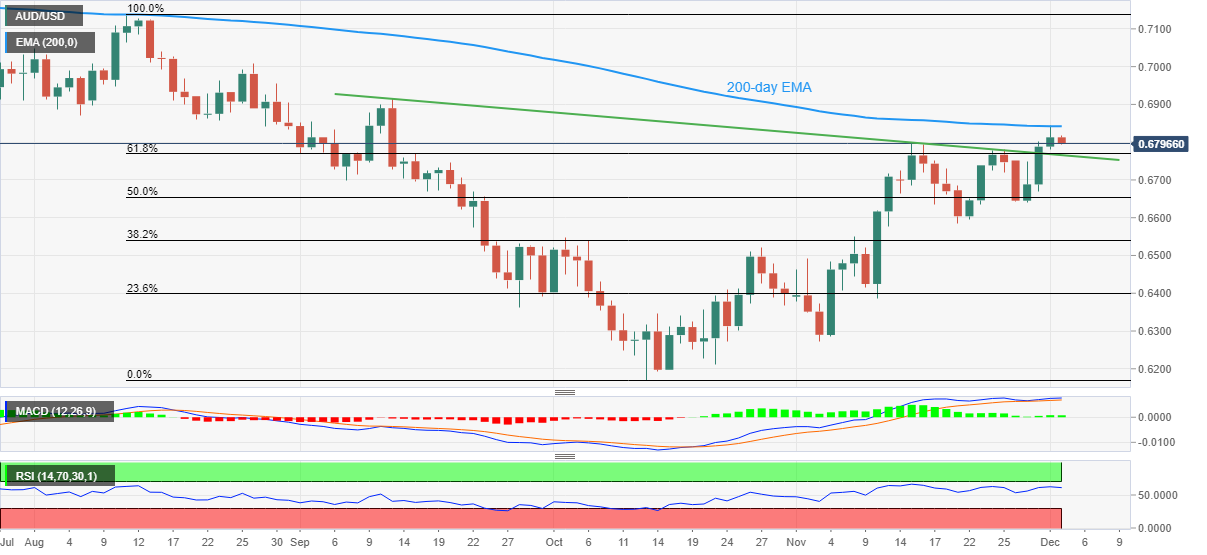
Trend: Limited downside expected
- US Dollar Index remains pressured at multi-day low amid dovish Fed bias.
- Downbeat US data, optimism surrounding China also weigh on DXY.
- Early signals for the US data suggest disappointment from today’s employment numbers.
US Dollar Index (DXY) flirts with the lowest levels since June-end while poking 104.55 during Friday’s Asian session. In doing so, the Greenback’s gauge versus the major six currencies justifies the market’s cautious mood ahead of the key US employment data for November.
That said, the US Dollar Index refreshed the multi-day low while dropping to 104.70 the previous day, around 104.50 at the latest, amid the broad-based weakness in the US Treasury bond yields. Also likely to favor the DXY bears is the optimism for China’s recovery from the Covid woes, as well as mixed US data. Above all, dovish comments from the Federal Reserve (Fed) officials keep DXY bearish.
On Wednesday, US Core Personal Consumption Expenditures (PCE) Price Index, the Federal Reserve’s preferred inflation gauge, matched 5.0% market forecasts on YoY but eased to 0.2% MoM versus 0.3% expected. Further, US ISM Manufacturing PMI for November eased to 49.0 versus 49.7 expected and 50.2 prior.
On the other hand, the consecutive three days of the downtrend of Chinese daily Covid infections from a record high allowed the policymakers to tease the “next stage” in battling the virus while announcing multiple easing of the activity-control measures.
Furthermore, the dovish bias of the Federal Reserve (Fed) Chairman Jerome Powell, as well as downbeat comments from US Treasury Secretary Janet Yellen, initially raised hopes of easy rate hikes.
Following that, Federal Reserve (Fed) Governor Michelle Bowman stated that (It is) appropriate for us to slow the pace of increases. Before him, Fed Governor Jerome Powell also teased the slowing of a rate hike while US Treasury Secretary Yellen also advocated for a soft landing. Further, Vice Chair of supervision, Michael Barr, also said, “We may shift to a slower pace of rate increases at the next meeting.” It’s worth noting that the recent comments from New York Fed’s John Williams seemed to have tested the US Dollar bears as the policymakers stated that the Fed has a ways to go with rate rises.
Amid these plays, the benchmark US 10-year Treasury bond yields slumped to 3.50% while the two-year counterpart printed 4.23% while poking the lowest levels since October by the press time. However, Wall Street closed mixed but the S&P 500 Futures remain mildly offered by the press time.
Looking forward, headline Nonfarm Payrolls (NFP) is likely to ease with a 200K print versus 261K prior while the Unemployment Rate could remain unchanged at 3.7%. It should be noted that a likely easing in the Average Hourly Earnings for the stated month could also weigh on the DXY.
Technical analysis
A three-month-old descending support line, around 104.50 by the press time, challenges the US Dollar Index bears amid the oversold RSI conditions.
| Pare | Closed | Change, % |
|---|---|---|
| AUDUSD | 0.68138 | 0.45 |
| EURJPY | 142.456 | -0.79 |
| EURUSD | 1.05268 | 1.15 |
| GBPJPY | 165.842 | -0.32 |
| GBPUSD | 1.22554 | 1.73 |
| NZDUSD | 0.63722 | 1.29 |
| USDCAD | 1.34294 | 0.07 |
| USDCHF | 0.9369 | -0.86 |
| USDJPY | 135.325 | -1.95 |
© 2000-2025. All rights reserved.
This site is managed by Teletrade D.J. LLC 2351 LLC 2022 (Euro House, Richmond Hill Road, Kingstown, VC0100, St. Vincent and the Grenadines).
The information on this website is for informational purposes only and does not constitute any investment advice.
The company does not serve or provide services to customers who are residents of the US, Canada, Iran, The Democratic People's Republic of Korea, Yemen and FATF blacklisted countries.
Making transactions on financial markets with marginal financial instruments opens up wide possibilities and allows investors who are willing to take risks to earn high profits, carrying a potentially high risk of losses at the same time. Therefore you should responsibly approach the issue of choosing the appropriate investment strategy, taking the available resources into account, before starting trading.
Use of the information: full or partial use of materials from this website must always be referenced to TeleTrade as the source of information. Use of the materials on the Internet must be accompanied by a hyperlink to teletrade.org. Automatic import of materials and information from this website is prohibited.
Please contact our PR department if you have any questions or need assistance at pr@teletrade.global.
